Mitsubishi Electronics LT-52148, LT-52246, LT-46246, LT-46148, LT-40148 User Manual

LCD FLAT PANEL HDTV
MODELS
148 Series
LT-40148, LT-46148, LT-52148
246 Series
LT-46246, LT-52246
OWNER’S GUIDE
•For questions:
-- Visit our website at www.mitsubishi-tv.com. -- E-mail us at MDEAservice@mdea.com.
-- Call Consumer Relations at 800-332-2119.
•For information on System Reset, please see the back cover.
•To order replacement or additional remote controls or Owner’s Guides, visit our website at www.mitsuparts.com or call 800-553-7278.
•Guidelines for setting up and using your new widescreen TV start on page 12.
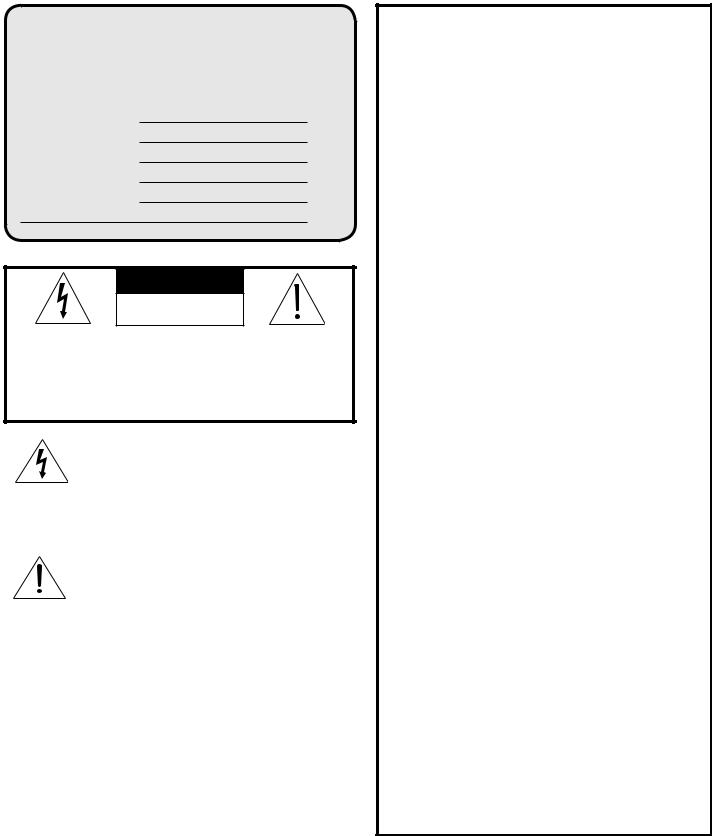
For Your Records
Record the model number, serial number, and purchase date of your TV. The model and serial numbers are on the back of the TV. Refer to this page when requesting assistance with the TV.
MODEL NUMBER
SERIAL NUMBER
PURCHASE DATE
RETAILER NAME LOCATION
CAUTION
RISK OF ELECTRIC SHOCK
DO NOT OPEN
CAUTION: TO REDUCE THE RISK OF ELECTRIC SHOCK, DO NOT REMOVE COVER (OR BACK). NO USER SERVICEABLE PARTS INSIDE.
REFER SERVICING TO QUALIFIED SERVICE PERSONNEL.
The lightning flash with arrowhead symbol within an equilateral triangle is intended to alert the user of the presence of uninsulated “dangerous voltage” within the product’s enclosure that may be of sufficient magnitude to constitute a risk of electric shock to persons.
The exclamation point within an equilateral triangle is intended to alert the user to
the presence of important operating and maintenance (servicing) instructions in the literature accompanying the product.
MAINS DISCONNECTION: The mains plug is used as the disconnect device. The disconnect device shall remain readily operable.
TV WEIGHT: This TV is heavy! Exercise extreme care when lifting or moving it. Lift or move the TV with a minimum of two adults. To prevent damage to the TV, avoid jarring or moving it while it is turned on. Always power off your TV, unplug the power cord, and disconnect all cables before moving it.
WARNING: To reduce the risk of fire or electric shock, do not expose this apparatus to rain or moisture.
WARNING: This product contains chemicals known to the State of California to cause cancer and/or birth defects or other reproductive harm.
FCC Declaration of Conformity
Product: |
LCD Flat Panel HDTV |
Models: |
LT-40148, LT-46148, LT-52148 |
|
LT-46246, LT-52246 |
Responsible |
Mitsubishi Digital Electronics |
Party: |
America, Inc. |
|
9351 Jeronimo Road |
|
Irvine, CA 92618-1904 |
Telephone: |
(800) 332-2119 |
This device complies with Part 15 of the FCC Rules. Operation is subject to the following two conditions:
(1)This device may not cause harmful interference, and
(2)this device must accept any interference received, including interference that may cause undesired operation.
Note: This equipment has been tested and found to comply with the limits for a Class B digital device, pursuant to part 15 of the FCC Rules. These limits are designed to provide reasonable protection against harmful interference in a residential installation. This equipment generates, uses and can radiate radio frequency energy and, if not installed and used in accordance with the instructions, may cause harmful interference to radio communications. However, there is no guarantee that interference will not occur in a particular installation. If this equipment does cause harmful interference to radio or television reception, which can be determined by turning the equipment off and on, the user is encouraged to try to correct the interference by one or more of the following measures:
-- Reorient or relocate the receiving antenna.
-- Increase the separation between the equipment and the receiver.
-- Connect the equipment into an outlet on a circuit different from that to which the receiver is connected.
-- Consult the dealer or an experienced radio/ TV technician for help.
Changes or modifications not expressly approved by Mitsubishi could cause harmful interference and would void the user’s authority to operate this equipment.
Features and specifications described in this owner’s guide are subject to change without notice.

Contents |
|
Important Information About Your TV |
|
Important Safety Instructions. . . . . . . . . . . . . . . . |
4 |
Installation and Operating Notes. . . . . . . . . . . . . . |
5 |
TV Guide Daily Access Requirements. . . . . . . . . . |
5 |
Cleaning Recommendations. . . . . . . . . . . . . . . . . |
5 |
1 Television Overview |
|
Package Contents. . . . . . . . . . . . . . . . . . . . . . . . |
6 |
Special Features of Your TV. . . . . . . . . . . . . . . . . |
6 |
TV Control Panel and Convenience Inputs. . . . . . . |
7 |
TV Main Panel. . . . . . . . . . . . . . . . . . . . . . . . . . . |
9 |
Stand Removal. . . . . . . . . . . . . . . . . . . . . . . . . |
11 |
2TV Setup
Guidelines for Setting Up and Using Your New
Widescreen TV. . . . . . . . . . . . . . . . . . . . . . . . 12 Initial TV Setup.. . . . . . . . . . . . . . . . . . . . . . . . . 14 Setting Up TV Inputs. . . . . . . . . . . . . . . . . . . . . 14 Controlling A/V Receiver Sound Volume.. . . . . . . 16 Using the TV with a Personal Computer. . . . . . . . 18 Using a CableCARD.. . . . . . . . . . . . . . . . . . . . . 20
3 |
TV Connections |
|
|
Before You Begin.. . . . . . . . . . . . . . . . . . . . . . . |
21 |
|
Cable Management. . . . . . . . . . . . . . . . . . . . . . |
21 |
|
HDTV Cable Box or Satellite Receiver, DVD |
|
|
Player, or Other Device with Component Video.. |
22 |
|
HDMI Device (Cable Box, Satellite Receiver, DVD |
|
|
Player, or Other Device).. . . . . . . . . . . . . . . . . . . |
22 |
|
DVI Video Device (Cable Box, Satellite Receiver, |
|
|
DVD Player, or Other Device).. . . . . . . . . . . . . . |
23 |
|
Standard Cable Box, Satellite Receiver, or Other |
|
|
Device with S-Video.. . . . . . . . . . . . . . . . . . . . |
23 |
|
Wall Outlet Cable (no cable box). . . . . . . . . . . . . |
24 |
|
Antenna with a Single Lead.. . . . . . . . . . . . . . . . |
24 |
|
Antennas with Separate UHF and VHF Leads. . . . |
24 |
|
VCR to an Antenna or Wall Outlet Cable.. . . . . . . |
25 |
|
VCR to a Cable Box (Audio & Video).. . . . . . . . . . |
25 |
|
Older Cable Box.. . . . . . . . . . . . . . . . . . . . . . . . |
26 |
|
A/V Receiver (Sound System) Using the TV’s |
|
|
Audio Output.. . . . . . . . . . . . . . . . . . . . . . . . . |
27 |
|
A/V Receiver with HDMI Output.. . . . . . . . . . . . . |
27 |
|
Camcorder. . . . . . . . . . . . . . . . . . . . . . . . . . . . |
28 |
|
Audio-Only Device.. . . . . . . . . . . . . . . . . . . . . . |
28 |
4 |
TV Operation and Features |
|
|
Choosing a Viewing Source.. . . . . . . . . . . . . . . . |
29 |
|
Sleep Timer.. . . . . . . . . . . . . . . . . . . . . . . . . . . |
29 |
|
Remote Control. . . . . . . . . . . . . . . . . . . . . . . . . |
30 |
ChannelView Channel Listings.. . . . . . . . . . . . . . 31
Status Display. . . . . . . . . . . . . . . . . . . . . . . . . . 32
Fav (Favorite Channels).. . . . . . . . . . . . . . . . . . . 33
TV Signals and Display Formats. . . . . . . . . . . . . 34
Viewing Camera Files and GalleryPlayer Images. . 35
5 TV Menus |
|
Main Menu. . . . . . . . . . . . . . . . . . . . . . . . . . . . |
37 |
Remote Control Keys for the TV Menu System. . . |
37 |
AV Menu. . . . . . . . . . . . . . . . . . . . . . . . . . . . . . |
38 |
Video Menu . . . . . . . . . . . . . . . . . . . . . . . . |
40 |
Audio Menu . . . . . . . . . . . . . . . . . . . . . . . . |
42 |
Captions Menu. . . . . . . . . . . . . . . . . . . . . . . . . |
43 |
Setup Menu.. . . . . . . . . . . . . . . . . . . . . . . . . . . |
44 |
Inputs Menu. . . . . . . . . . . . . . . . . . . . . . . . . . . |
50 |
Lock Menu. . . . . . . . . . . . . . . . . . . . . . . . . . . . |
51 |
Pass Codes.. . . . . . . . . . . . . . . . . . . . . . . . |
51 |
Parent Menu. . . . . . . . . . . . . . . . . . . . . . . . |
51 |
Other Menu (Alternate Rating System). . . . . . |
51 |
Bypassing TV Locks.. . . . . . . . . . . . . . . . . . |
51 |
6 NetCommand IR Control |
|
About NetCommand IR Control.. . . . . . . . . . . . . |
54 |
IR Emitter Placement. . . . . . . . . . . . . . . . . . . . . |
55 |
Initial NetCommand Setup for Most Devices.. . . . |
56 |
Adding or Removing Device Keys from |
|
NetCommand Control.. . . . . . . . . . . . . . . . . . . |
56 |
NetCommand Specialized Device Keys. . . . . . . . |
57 |
Operating NetCommand-Controlled Devices. . . . |
58 |
Setting Up NetCommand Control of an |
|
A/V Receiver. . . . . . . . . . . . . . . . . . . . . . . . . . |
60 |
Appendices
Appendix A: Specifications. . . . . . . . . . . . . . . . 66
Appendix B: Bypassing the Parental Lock. . . . . . 67
Appendix C: Programming the Remote Control. . 69
Appendix D: TV Guide Daily (246 Series TVs).. . . 76
Appendix E: NetCommand HDMI Control of
CEC Devices. . . . . . . . . . . . . . . . . . . . . . . . . . 80
Appendix F: Troubleshooting. . . . . . . . . . . . . . . 83
Trademark and License Information. . . . . . . . . . . 90
Mitsubishi TV Software. . . . . . . . . . . . . . . . . . . . 91
Warranty. . . . . . . . . . . . . . . . . . . . . . . . . . . . . . . 92
Index. . . . . . . . . . . . . . . . . . . . . . . . . . . . . . . . . . 94
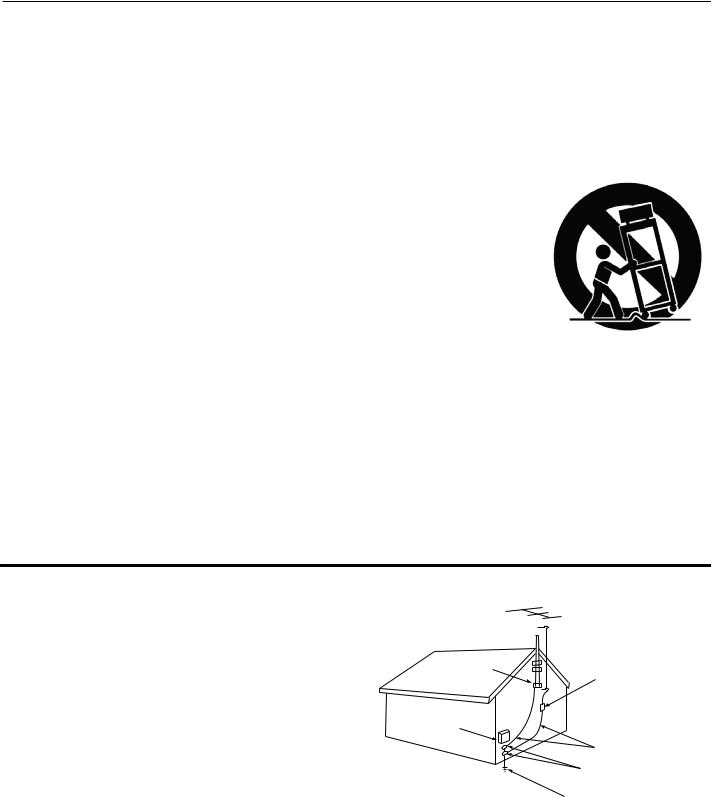
4
Important Safety Instructions
Please read the following safeguards for your TV and retain for future reference. Always follow all warnings and instructions marked on the television.
1)Read these instructions.
2)Keep these instructions.
3)Heed all warnings.
4)Follow all instructions.
5)Do not use this apparatus near water.
6)Clean only with dry cloth.
7)Do not block any ventilation openings. Install in accordance with the manufacturer’s instructions.
8)Do not install near any heat sources such as radiators, heat registers, stoves, or other apparatus (including amplifiers) that produce heat.
9)Do not defeat the safety purpose of the polarized or grounding-type plug. A polarized plug has two blades with one wider than the other. A grounding type plug has two blades and a third grounding prong. The wide blade or the third prong are provided for your safety. If the provided plug does not fit into your outlet, consult an electrician for replacement of the obsolete outlet.
10)Protect the power cord from being walked on or pinched particularly at plugs, convenience
receptacles, and the point where they exit from the apparatus.
11)Only use attachments/accessories specified by the manufacturer.
12)Use only with the cart, stand, tripod, bracket, or table specified
by the manufacturer, or sold with the apparatus. When
a cart is used, use caution when moving the cart/apparatus combination to avoid injury from tip-over.
13)Unplug this apparatus during lightning storms or when unused for long periods of time.
14)Refer all servicing to qualified service personnel. Servicing is required when the apparatus has been damaged in any way, such as power-supply cord or plug is damaged, liquid has been spilled or objects have fallen into the apparatus, the apparatus has been exposed to rain or moisture, does not operate normally, or has been dropped.
Outdoor Antenna Grounding
If an outside antenna or cable system is connected to the TV, be sure the antenna or cable system is grounded so as to provide some protection against voltage surges and built-up static charges.
Replacement Parts
When replacement parts are required, be sure the service technician has used replacement parts specified by the manufacturer or have the same characteristics as the original part. Unauthorized substitutions may result in fire, electric shock or other hazards.
%8!-0,%0/& !.4%..! '2/5.$).'
'2/5.$ #,!-0
%,%#42)#
3%26)#% %15)0-%.4
.%#% #.!4)/.!, %,%#42)#!, #/$%

 !.4%..! ,%!$ ).$7)2%
!.4%..! ,%!$ ).$7)2%
!.4%..! $)3#(!2'% 5.)4.%# !24)#,%#
'2/5.$).' #/.$5#4/23.%# !24)#,%#
'2/5.$ #,!-03
0/7%2%3%26)#% '2/5.$).' %,%#42/$%$3934%-.%# !244 0!244(

5
Installation Notes |
Cleaning Recommendations |
Wall Mount Requirements
For wall-mounting, see “Stand Removal,” page 11.
Use with other than the authorized accessories may cause the TV to become unstable, which can cause damage to the product or possible injury.
Normally, light dusting with a dry, non-scratching duster will keep your TV clean. If cleaning beyond this is needed, please use the following guidelines:
First, turn off the TV and unplug the power cord from the power outlet.
Custom cabinet installation must allow for proper air circulation around the television.
NOTE TO CATV SYSTEM INSTALLER: THIS REMINDER IS PROVIDED TO CALL THE CATV SYSTEM INSTALLER’S ATTENTION TO ARTICLE 820-40 OF THE NEC THAT PROVIDES GUIDELINES FOR THE PROPER GROUNDING AND, IN PARTICULAR, SPECIFIES THAT THE CABLE GROUND SHALL BE CONNECTED TO THE GROUNDING SYSTEM OF
THE BUILDING, AS CLOSE TO THE POINT OF CABLE ENTRY AS PRACTICAL.
If Your TV Gets Damaged
Crystalline liquid may leak from the LCD panel and broken glass may be scattered.
CAUTION: The crystalline liquid is toxic. Avoid contact with your skin, eyes, or mouth. DO NOT touch the broken glass or crystalline liquid. DO NOT get glass fragments or crystalline liquid into eyes or mouth. Should either contact with your eyes or mouth, rinse the contacted area thoroughly with water and consult your doctor.
Disposal of Your TV
Top and Sides of the TV
•Occasionally clean dust build-up from the air-intake grilles on the back and sides of the TV. Clean using a vacuum cleaner with a brush attachment.
•Gently wipe down your TV with a soft, non-abrasive cloth such as cotton flannel or a clean cloth diaper, lightly moistened with water. Dry with a second dry, soft, non-abrasive cloth.
•For oily dirt, add a few drops of mild liquid detergent, such as dishwashing detergent, to the water used to moisten the cloth. Rinse with a second cloth moistened only with water. Dry with a third dry, soft, non-abrasive cloth.
•Glossy Surfaces: Take special care when cleaning the TV’s glossy surfaces.
-- Always shake or brush the cleaning cloth first to remove any dirt particles.
-- Wipe the glossy areas gently, without applying pressure.
-- If necessary, lightly dampen the cloth with water. Use no chemical or abrasive cleaners.
LCD Screen Cleaning
The LCD panel contains a small amount of crystalline liquid and the fluorescent tube in the panel contains mercury. Both are toxic and should not be touched.
DO NOT dispose of the TV with general household waste. THE LAMPS INSIDE THIS PRODUCT CONTAIN MERCURY AND MUST BE RECYCLED OR DISPOSED OF ACCORDING TO LOCAL, STATE, AND FEDERAL LAWS. For disposal or recycling information, contact your local authorities or the Electronic Industries Alliance at www.eiae.org.
TV Software
Do not attempt to update the software of this TV with software or USB drives not provided by or authorized by Mitsubishi Digital Electronics America, Inc. Non-authorized software may damage the TV and will not be covered by the warranty.
TV Guide Daily Access Requirements
TV Guide Daily listings are not provided by Mitsubishi Digital Electronics America, Inc. Operation of TV Guide Daily requires over-the-air or direct cable (no cable box) access to stations carrying TV Guide Daily program listings. If listings are not available in your area or become discontinued by the local provider, TV Guide Daily will not operate. TV Guide Daily does not provide program listings for satellite TV systems.
IMPORTANT
DO NOT apply any type of liquid to the surface of the TV screen.
•Use only use a soft, dry cloth to clean the LCD screen. Do not use any liquids.
•Wipe the screen gently with an up and down motion.
•Clean the entire screen evenly, not just sections of the screen.
General Cleaning Precautions
•DO NOT allow liquid to enter the TV through the ventilation slots or any crevice.
•DO NOT use any strong or abrasive cleaners, as these can scratch the surfaces.
•DO NOT use any cleaners containing ammonia, bleach, alcohol, benzene, or thinners, as these can dull the surfaces.
•DO NOT spray liquids or cleaners directly on the
TV’s surfaces.
•DO NOT scrub or rub the TV harshly. Wipe it gently.

6 1 Television Overview
Package Contents
Please take a moment to review the following list of items to ensure that you have received everything.
1.Remote Control
2.Two AA Batteries
3.Cable Tie with Pin
4.Owner’s Guide
5.Quick Reference Guide
6.Quick Connect Guide
7.Product Registration Card
8.IR Emitter cable (two-ended with 148 series; four-ended with 246 series)
1 |
A |
3 |
|
A 2 |
|
|
|
|
|
8 |
|
Special Features of Your TV
Your new high-definition widescreen television has many special features that make it the perfect center of your home entertainment system, including:
1080p High-Definition LCD Display System
Your Mitsubishi LCD Flat Panel HDTV uses a full 1920 x 1080 LCD panel to create the picture you see on the screen. All images are displayed at 1080p. The TV uses Plush 1080p™ to convert lower-resolution signals to 1080p for display.
Smooth120Hz™ Film Motion
Smooth120Hz™ Film Motion makes fast-moving images appear smoother and more fluid, free from motion
blur. In this LCD Flat Panel HDTV, Smooth120Hz™ Film Motion doubles the traditional progressive scan frame rate and creates new frames of video between the traditional frames to smooth moving images. Smooth120Hz™ Film Motion also smooths film judder (image vibration) that may be present in film-based content such as movies.
16:9 Widescreen Picture Format
Enjoy a full theatrical experience in the comfort of your home. View pictures as film directors intended them. Digital TV broadcasts, DVDs and newer video game consoles support this widescreen format.
Integrated HDTV Tuner
Your widescreen Mitsubishi HDTV has an internal HDTV tuner able to receive both over-the-air HDTV broadcasts (received via an antenna) and non-scrambled digital cable broadcasts, including non-scrambled HDTV cable programming.
High-Definition Video Inputs
•Component Video Inputs. Also called Y/Pb/Pr inputs, these inputs receive standard analog video formats of 480i, 480p, 720p, and 1080i high-defini- tion signals. This provides a high level of flexibility when connecting DVD players/recorders, cable boxes, and satellite receivers.
•HDMI Inputs. These inputs accept digital 480i, 480p, 720p, 1080i, and 1080p video signals plus PCM digital stereo signals. The HDMI™ inputs can also accept a variety of PC signals and resolutions. These inputs support HDMI 1.3 Deep Color (up to 36 bits) and the x.v.Color extended color gamut.
Used with an adapter, these inputs also accept compatible digital DVI video signals. HDMI inputs provide additional high-performance, high-definition connections for maximum flexibility
in your choice of home theater products. The HDMI inputs are HDCP copy-protection compatible.
Easy Connect Auto Input Sensing
Easy Connect™ Auto Input Sensing automatically recognizes when you plug in an input and prompts you to assign a name to it. The TV ignores any unused inputs, so the result is an uncluttered Input Selection menu where you can easily find and select connected devices by name.
Home Theater Control
NetCommand with IR Learning
Your Mitsubishi HDTV offers a new level of networking that seamlessly integrates selected older A/V products with new and future digital products. NetCommand® supports IR (infrared) control of products such as VCRs,

DVD players, cable boxes, and satellite receivers. NetCommand can “learn” remote control signals directly from many devices, allowing you to create a customized NetCommand-controlled home-theater system.
NetCommand for HDMI
HDMI devices with Consumer Electronics Control (CEC) capabilities may be compatible with the TV’s NetCommand for HDMI feature. Compatible devices can receive control signals through the HDMI connection.
GalleryPlayer
GalleryPlayer allows you to transform your TV into an art showcase. Beautiful high-definition images to display on your TV are available for purchase at
Mitsubishi.GalleryPlayer.com. Several sample images are provided with the TV. See page 49.
TV Guide Daily Interactive
Program Guide System
246 Series TVs. The TV Guide Daily system is an on-screen program guide for cable and over-the-air reception. This subscription-free guide system lists regular, digital, and high-definition programming. Note that when the system is first set up, it may take up to 24 hours to begin receiving TV program listings.
Swivelling Stand
The included stand allows the TV to be swiveled manually up to 30 degrees left or right to the best viewing angle.
Top View
30° |
30° |
|
Front |
The TV can be swiveled up to 30 degrees left or right.
TV Control Panel and
Convenience Inputs
Control Panel
Buttons on the control panel duplicate commonly used keys on the remote control. The upper labels show control functions when no TV menus are displayed; the lower labels indicate functions when TV menus are displayed or when a special function has been activated. See “Remote Control,” page 30, for a full description of the functions of these buttons.
A/V Reset
If you wish to reset the A/V (Audio/Video) settings back to the factory defaults:
•To reset all settings at once, press GUIDE and FORMAT on the control panel at the same time.
•To reset the defaults for individual inputs, use the Reset selection on the AV menu. See “AV Menu,” page 38.
1. Television Overview |
7 |
POWER SYSTEM |
VOL |
CH |
FORMAT MENU |
GUIDE INPUT |
RESET |
|
|
|
|
|
ADJ |
ADJ |
ENTER MENU |
CANCEL |
|
|
|
SYSTEM
RESET
System Reset Button
If the TV fails to respond to the remote control, con- trol-panel buttons, or will not power on/off, press the SYSTEM RESET button on the control panel.
The LED on the front panel will flash quickly for about one minute. When the LED stops flashing, you may turn on the TV. Recent setting changes you made before using SYSTEM RESET may be lost.
Convenience Inputs
•INPUT 4 is a readily accessible set of input jacks for a camcorder, game, or other audio/video device.
•A USB photo port lets you view JPEG images from a USB drive or card reader.
Note:
To connect a standard video device (composite video): connect the single (yellow) video cable to the Y/VIDEO jack.
INPUT 4
Pr
Pb
Y/
VIDEO
R
AUDIO
L
USB

8 |
1. Television Overview |
Front-Panel Indicators
•STATUS indicator. Off during normal TV operation.
•POWER/TIMER indicator. Lit when TV is powered on; flashes when TV is powered off and the auto-on TV Timer is set.
•IR Sensor (Infrared Sensor). Detects infrared signals emitted by the remote control.
STATUS POWER |
IR Sensor |
POWER STATUS
IR Sensor
148 Series TVs
246 Series TVs
Off |
Steady On |
Slow Blinking |
Fast Blinking |
||
|
|
|
|
|
|
POWER Indicator |
|
|
|
||
|
|
|
|
||
LED Color |
TV Condition |
|
Additional Information |
||
None |
Standby condition. |
|
Normal operation. |
||
|
|
|
|
||
|
|
|
|
||
Green |
TV is powered on. |
|
Normal operation. |
||
|
|
|
|||
Green |
TV powered off, auto-on timer is set. |
Normal operation. TV can be turned on at any time. |
|||
|
|
|
|
|
|
Green |
1. TV just plugged into AC outlet. |
Wait approximately one minute for blinking to stop before turning |
|||
on. Normal operation. |
|||||
|
|
|
|
||
|
2. AC just restored after power failure. |
|
|||
|
3. TV rebooting after System Reset |
|
|||
|
used. |
|
|
||
4. TV rebooting after power fluctuation or receiving abnormal digital signals from a digital channel or digital device.
5. You have begun the procedure to update software from an authorized flash memory device.
STATUS Indicator
LED Color |
TV Condition |
Additional Information |
None |
Normal TV on or standby condition. |
Normal operation. |
|
|
|
Red |
TV may require service. |
Turn off the TV and unplug the set from the AC power source. |
|
Wait one minute and then plug the set back in. See Appendix F. |
|
|
|
|
|
|
If the LED is still on, contact your dealer or a Mitsubishi |
|
|
Authorized Service Center. Go to www.mitsubishi-tv.com or call |
|
|
1-800-332-2119 to receive Authorized Service Center information. |
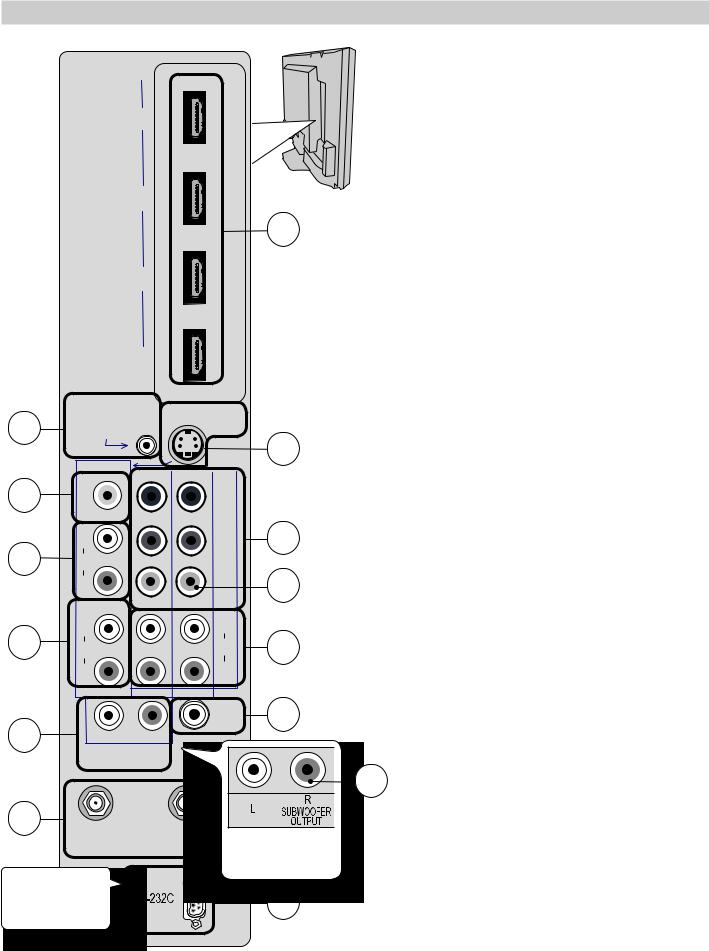
1. Television Overview |
9 |
TV Main Panel
1. ANT 1/ANT 2 (Antenna)
HDMI
VIDEO: 480i, 480p /720p 1080i /1080p AUDIO:
PCM STEREO
PC: VGA, W-VGA, SVGA, W-SVGA, XGA, W-XGA, SXGA / 720p/1080p
4
3
2
1
If you are connecting an antenna or direct cable service without a cable box, connect the main antenna or cable source to ANT 1. Use ANT 2 for a second source.
ANT 1 and ANT 2 can each receive digital and analog over-the-air channels from a VHF/UHF antenna or nonscrambled digital/analog cable source.
ANT 1/MAIN and CableCARD™
Use ANT 1/MAIN to receive premium subscription
8cable TV service authorized by the CableCARD™ access card. The CableCARD access card is provided by your local cable company.
2. Component Video (INPUT 1, INPUT 2)
Y Pb Pr Component Video (480i/480p/720p/1080i)
Use these jacks to connect devices with component video outputs, such as DVD players, external HDTV receivers, or compatible video game systems. Use the adjacent AUDIO R and L jacks for INPUT 1 or INPUT 2 if you wish to send audio to the TV. See Appendix A specifications for signal compatibility.
|
IR-NetCommand |
|
S-VIDEO |
12 |
Output / External |
|
|
Controller Input |
|
|
|
|
INPUT3 |
|
|
5 |
|
|
Pr80i) |
|
|
0 |
|
|
VIDEO |
|
0p / 1 |
|
L |
|
Pbp/72 |
6 |
AUDIO |
|
i / 480 |
|
|
0 |
|
|
R |
|
(48 |
|
|
|
|
|
DVI/PC |
Y |
Y/ VIDEO |
7 |
L |
|
L |
AUDIO |
|
AUDIO |
|
|
|
||
|
R |
|
R |
|
|
INPUT2 |
INPUT1 |
|
|
|
DIGITAL |
|
|
|
AUDIO |
9 |
|
|
OUTPUT |
L |
R |
|
AVR AUDIO
OUTPUT
1
3. AUDIO L and R (INPUT 1, INPUT 2)
4Analog stereo inputs shared by more than one video input.
•INPUT 1 audio jacks are for use with INPUT 1 component video (Y Pb Pr) or composite video (single yellow cable).
•INPUT 2 audio jacks are for use with INPUT 2 component
video exclusively.
2
4. S-VIDEO (INPUT 3)
5Connect an S-Video device to this input. Use the AUDIO R and L jacks for INPUT 3 (item 6) if you wish to send audio to the TV.
5. Composite Video (INPUT 1, INPUT 3)
3 |
Use the VIDEO jacks to connect a VCR, Super VHS (S-VHS) |
|||
|
|
|||
|
|
VCR, DVD player, standard satellite receiver, or other A/V device |
||
|
|
to the TV. Use the adjacent AUDIO R and L inputs for INPUT 1 or |
||
11 |
INPUT 3 if you wish to send audio to the TV. Note that the INPUT |
|||
3 composite video jack is automatically disabled when you |
||||
|
|
|
|
connect to S-VIDEO. |
|
|
|
10 |
6. AUDIO L and R (INPUT 3) |
|
|
|
||
|
|
|
Analog stereo inputs shared by INPUT 3 composite |
|
|
|
|
|
|
|
|
|
|
|
|
|
|
|
video and S-Video. |
|
|
|
|
|
|
|
|
|
|
ANT2/AUX |
ANT1/MAIN |
Subwoofer output |
|
|
offered on 246 |
RS-232C jack |
|
Series TVs. |
|
|
|
offered on 246 |
|
13 |
Series TVs. |
|
|
|
|
7. DVI/PC INPUT AUDIO
Use the DVI/PC INPUT AUDIO jack when connecting a DVI device to one of the TV’s HDMI inputs using a DVI-to-HDMI cable. These jacks allow you to send left and right analog audio from your computer or other DVI device to the TV.

10 |
1. Television Overview |
TV Main Panel, continued
8. HDMI™ Inputs (High-Definition Multimedia Interface)
The HDMI inputs support uncompressed standard and highdefinition digital video formats and PCM digital stereo audio.
Use the HDMI inputs to connect to CEA-861 HDMI compliant devices such as a high-definition receiver or DVD player. These inputs support 480i, 480p, 720p, 1080i, and 1080p video formats.
Mitsubishi recommends you use category 2 HDMI cables, also called high-speed HDMI cables, to connect HDMI 1.3 source devices. High-speed category 2 cables bring you the full benefits of Deep Color and x.v.Color.
These HDMI inputs can also accept digital DVI video signals. To connect a DVI input, use an HDMI-to-DVI adapter or cable plus analog audio cables. Connect the analog audio cables to the DVI/PC INPUT AUDIO jacks on the TV to receive left and right stereo audio from your DVI device.
The TV’s HDMI inputs are compatible with many DVI-D and HDMI computer video signals. For additional information on PC compatibility, see “Using the TV with a Personal Computer,” page 18, and Appendix A, “Specifications,” page 66.
These inputs are HDCP (High-Bandwidth Digital Copy Protection) compliant
These inputs certified for proper interoperability with other products certified by Simplay™.
9. AVR AUDIO OUTPUT
Use AVR AUDIO OUTPUT to send analog audio of the program currently shown on the screen to an analog A/V surround sound receiver or stereo system. Digital audio from digital channels and HDMI devices is converted to analog audio by the TV. This is the only audio connection needed between it and the TV if using an analog A/V receiver or stereo system.
IMPORTANT
Selecting Audio Output Type, 246 Series TVs
The red audio jack can output either right stereo audio for an A/V receiver or mono bass audio for a subwoofer. Select the output type when prompted in the Auto Output Sensing screen.
10. SUBWOOFER OUTPUT
246 Series TVs. Connect a powered subwoofer to the
SUBWOOFER OUTPUT jack. Select Subwoofer when the
Auto Output Sensing screen displays.
11. DIGITAL AUDIO OUTPUT
This output sends Dolby Digital or PCM digital audio to your digital A/V surround sound receiver. Analog audio from analog channels and devices is converted by the TV to PCM digital audio. If you have a digital A/V receiver,
HDMI Cable Categories
HDMI cables are available as Category 1 and Category 2 types.
•Category 2 Cables (also called high-speed HDMI cables). Newer, HDMI 1.3-compliant DVD players, video games, and set-top boxes require Category 2 cables, suitable for clock frequencies up to 340 MHz or data rates of up to 10.2 gigabits per second. Use category 2 cables for high-speed 1080p HD signals carrying extended color encodings (i.e., 30 or more bits, also called Deep Color). Category 2 cables are also suitable for standard HDTV signals.
•Category 1 Cables (also called standard HDMI cables). Category 1 cables may be unmarked. They are suitable for standard HDTV 720p and 1080i signals with 8-bit color depth. Use category 1 cables for clock frequencies up to 74.25 MHz or data rates of up to 2.23 gigabits per second.
in most cases this is the only audio connection needed between the TV and your A/V receiver.
12. IR NetCommand Output/External Controller Input
IR emitters connected to this jack are used by the TV’s NetCommand system to send control signals to external IR remote-controlled devices such as cable boxes, VCRs, DVD players, satellite receivers and audio receivers.
When NetCommand is not in use, this jack can be switched to receive wired IR control signals from external system controllers. To switch this jack to an input, connect the external controller’s IR output to this jack, then:
1.Press MENU to display the TV menu.
2.Enter the number sequence 2, 4, 7, 0 to display the
Installer menu.
3.Highlight the WIRED IR selection and press ENTER to change the setting from OFF to ON.
To revert to NetCommand control:
1.Disconnect the IR device.
2.Press MENU to display the TV menu.
3.Enter the number sequence 2, 4, 7, 0 to display the
Installer menu.
4.Highlight the WIRED IR selection and press ENTER to change the setting from ON to OFF.
Note: When the WIRED IR option is set to ON (control by an external device), the Low Power setting for Energy Mode is unavailable.
13. RS-232C
Use the RS-232C interface to receive control signals from compatible home-theater control devices.
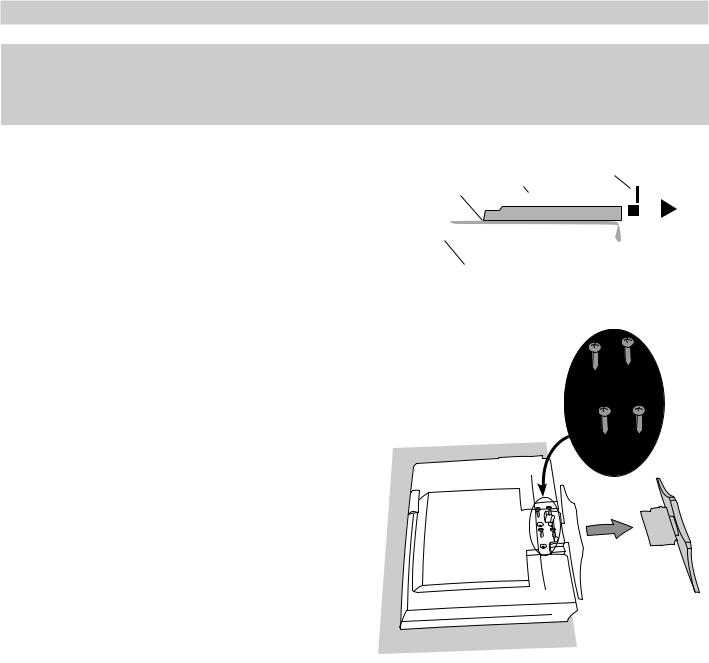
1. Television Overview |
11 |
Stand Removal
CAUTION
At least TWO PEOPLE are needed to safely remove the stand. Have one person hold the TV while the other person removes the stand. Failure to follow these recommendations may result in personal injury and damage to the product.
Stand-Removal Procedure:
1.Disconnect the TV’s AC power cord from the AC power outlet.
2.Spread the protective sheet that was wrapped around the TV on a flat, even surface, such as a sturdy table. The protective sheet will help prevent damage to the display.
IMPORTANT: To avoid damaging the screen, make sure there are no foreign objects under or on top of the protective sheet.
3.Position one person on each side of the TV (left and right sides). Have each person firmly grasp their side of the TV and gently place it face down on the protective sheet with the display stand hanging over the edge of the table. See the illustration to the right.
4.Use a magnetic philips screwdriver to remove the four stand screws from the recessed holes (see illustration to right). Note: A regular screwdriver can be used with a separate magnetic pick-up tool.
5.While one person holds the TV with both hands, have the other person grasp the plastic portion of the stand (see illustration to the right) and remove the stand by pulling it away from the TV in the direction of the large arrow shown in both illustrations.
6.The TV is now ready for wall mounting. See “Wall Mount Kit” below.
Wall Mounting Kit (purchased separately)
To order a Wall Mounting Kit, please contact Peerless Industries, Inc. at (800) 473-3753 or visit www.peerlessmounts.com. Use wall mounting kit Model ST650.
Note: Complete instructions are included with the kit.
To order a Wall Mounting Kit from Mitsubishi Digital Electronics America, Inc., please visit www.mitsuparts.com or call (800) 553-7278.
1SPUFDUJWF |
57 |
4UBOE |
|
||
|
|
|
TIFFU |
|
|
5BCMF |
|
|
TV Back
Cover
Protective Sheet
CAUTION: Using this TV with other than the authorized accessories may cause the TV to become unstable, which can cause damage to the product or possible injury.
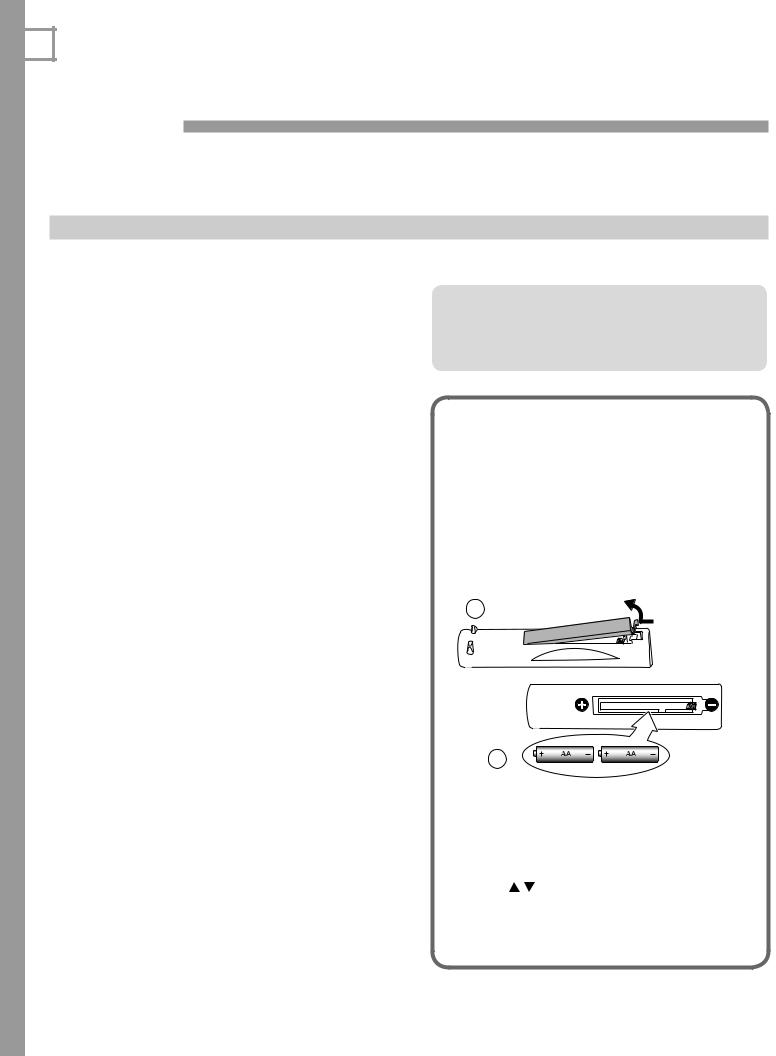
12 |
2 TV Set-Up
Guidelines for Setting Up and Using Your New Widescreen TV
Getting Started
1.Review the important safety, installation, and operating information at the beginning of this book.
2.Choose a location for your TV.
•Allow at least four inches of space on all sides of the TV to help prevent overheating. Overheating may cause premature failure of the TV.
•Avoid locations where light may reflect off the screen or where the TV is exposed to direct sunlight.
•Refer also to “Installation Notes,” page 5.
3.Install the batteries in the remote control. See this page for instructions. See page 30 for more on use of the remote control.
4.Plug your TV into a power outlet. The green LED on the front of the TV will start blinking rapidly. After the green LED stops blinking, press the POWER key to power on the TV.
5.When the Welcome screen appears the first time you power on the TV, select a language for TV menus. You can later change the language through the Setup menu.
6.Connect your audio/video (A/V) devices to the TV and perform initial setup.
•See chapter 3, “TV Connections,” for connection diagrams.
•See the following pages for initial TV setup and use of the Auto Input Sensing feature.
•To connect the TV to a personal computer, see “Using the TV with a Personal Computer,” page 18.
•See chapter 6, “NetCommand IR Control,” to perform NetCommand IR “learning” to set up control of your home theater.
•To set up NetCommand HDMI control of CECenabled devices, see Appendix E.
7.Mitsubishi recommends you perform a channel scan for channels received on ANT 1 and ANT 2. See “Initial TV Setup” page 14.
8.You can now start watching TV or you can perform additional setup and customization through the TV menus.
Turning the TV On or Off
To turn the TV on or off, point the remote control at the front of the TV and press the POWER button. Alternatively, press the POWER button on the TV’s control panel.
Installing the Remote Control
Batteries
1.Remove the remote control’s back cover by gently pressing in the tab and lifting off the cover.
2.Load the batteries, making sure the polarities
(+)and (-) are correct. For best results, insert the negative (-) end first.
3.Snap the cover back in place.
The remote control requires two AA alkaline batteries.
2
When You First Power On the TV
Language for Menus
TV for the first time.
to select either English or Spanish for all menus. You can later change the language selection through the Setup > Language menu. See page 44.
2. TV Setup |
13 |
Additional TV Setup
1.Review chapter 5, “TV Menus,” to customize TV operation. Press the MENU key to enter the menu system. Some examples of settings you may wish to change include:
•Fav. Use an on-screen menu to create custom lists of your favorite channels from ANT 1 and ANT 2. See Setup > Edit, page 45.
•Order. Rearrange the device icons in the Input Selection menu to put frequently used icons near the front. See Inputs > Order, page 50.
•Name. Change the device types that appear in the Input Selection menu. See Inputs >
Name options, page 50.
•Parental Locks. Restrict TV viewing by program rating, by channel, or by time of day. You can also disable the control-panel buttons if you have small children.
-- To restrict TV use by program rating, see the Lock > Parent menu, page 52.
-- To lock the control-panel buttons, use the
Lock > Control Panel menu, page 53.
-- To restrict TV use by channel, see Setup > Edit > Lock, page 45.
•Video Settings. Change video adjustments to get the best picture for your viewing conditions. See “AV Menu,” page 38.
Note: You may wish to change the Picture Mode from the default Brilliant to either Bright or Natural, which are suitable for most home viewing.
2.To see a demo of beautiful images in high-definition from the Mitsubishi.GalleryPlayer.com collection, see page 49.
3.To program the remote control to operate A/V devices not under NetCommand control, see Appendix C, “Programming the Remote Control.”
4.246 Series TV. To set up the TV Guide Daily system, see Appendix D.
TV Operation
1.Review chapter 4, “TV Operation and Features,” for TV features including:
•Input Selection (viewing source). Select a connected program source to watch, such as a VCR, DVD player, or antenna. Press INPUT on the remote control to select from icons for the TV inputs. See “Choosing a Viewing Source,” page 29.
•Listings. Press GUIDE.
-- For ChannelView™ display of listings on ANT 1 and ANT 2, see “ChannelView Channel Listings,” page 31.
-- 246 Series TV. If you have set up and
activated the TV Guide Daily system, press the GUIDE key to display listings using TV Guide Daily. See Appendix D,
•Picture Formats. Press FORMAT to cycle through picture sizes and shapes to find the one best suited to the current program. See “TV Signals and Display Formats,” page 34.
2.To view still and moving digital camera images on the TV, see page 35, “Viewing Camera Files and GalleryPlayer Images.”
3.To control A/V devices with NetCommand, see page 58, “Operating NetCommand-Controlled Devices.”
TV Cleaning
See “Cleaning Recommendations,” page 5.
Assistance
•For troubleshooting, service, and product support, see Appendix F.
•For warranty information, see the TV warranty on page 92.

14 |
2. TV Setup |
Initial TV Setup
Use the Setup menu for basic TV setup options.
1. |
Press MENU to open the Main menu. |
2. |
Press to highlight the Setup icon and display the |
|
Setup menu. |
Memorizing Channels
For ANT 1 and ANT 2
Note: 246 Series TV. If using a CableCARD, the TV will automatically acquire the complete list of available channels from the service pro-
vider. Perform channel memorization for ANT 1 CableCARD service only if you need to reacquire the channel list.
To start channel memorization
1.Connect the incoming cable to ANT 1 or ANT 2. This is the cable from an antenna or a cable service without a cable box.
2. With the Setup menu displayed, press to highlight the Scan icon.
Start channel memorization from the Setup menu.
3. Press to highlight an input selection based on your connections:
Input |
Condition |
|
|
Ant 1 Air |
When connected to an indoor or |
Ant 2 Air |
outdoor antenna |
|
|
Ant 1 Cable |
When connected to direct cable (no |
Ant 2 Cable |
cable box) |
|
|
4.Press to highlight the on-screen START button.
to highlight the on-screen START button.
5.Press ENTER to start automatic channel memorization.
To stop channel memorization before completion, press CANCEL.
6.When memorization is complete you can:
•Press MENU once to return to the top row of icons.
•Press MENU again to return to the Main menu.
•Press EXIT to watch TV.
After channels have been memorized:
• To tune to memorized channels, press CH / while watching TV on the ANT 1 or ANT 2 input.
•Use the Setup > Edit menu (page 45) for additional channel options, such as adding or deleting channels from memory, naming channels, and saving favorite channels in custom memory banks.
See chapter 5, “TV Menu Settings,” to:
•Set the TV clock (page 46)
•Set the TV Timer (page 47) to have the TV power on at a preset time.
•Select an Energy Mode to manage power use while the TV is off (page 48).
Setting Up TV Inputs
When You First Connect a Device
The TV’s Easy Connect™ Auto Input Sensing feature detects most connections automatically.
Note: For connection and setup of a personal computer, see the information on page 18.
Auto Input Sensing for Most Devices
When you first connect a device, the TV will:
a.Detect the connection and automatically switch to the input
b.Prompt you to identify the device type (if not recognized automatically)
c.Prompt you to perform NetCommand set-up for the device, if available
d.Repeat these steps for any additional newly detected devices
See below for connections which trigger Auto Input Sensing.
Auto Input Sensing Available
Y/VIDEO (detected as composite video)
Y/VIDEO plus Pb (detected as component video)
S-VIDEO
HDMI *
USB (USB photo port)
INPUT 4 AUDIO (with video plug, see page 28.
Auto Output Sensing Available
Digital Audio OUTPUT (orange jack)
AVR AUDIO OUTPUT (red jack)
AVR AUDIO OUTPUT/
SUBWOOFER OUTPUT (red jack, 246 Series TVs)
No Auto Sensing
ANT 1 and ANT 2
*If the device is powered off when connected, detection occurs when the device is next powered on.
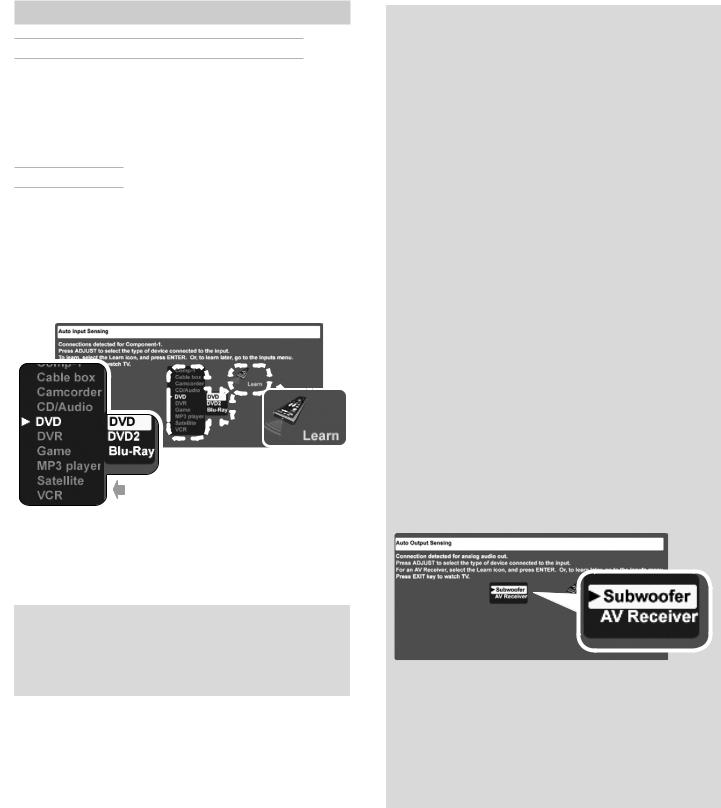
2. TV Setup |
15 |
Setting Up TV Inputs, continued
Auto Input Sensing for CEC-Enabled Devices
When the TV’s NetCommand for HDMI feature is enabled, most CEC-enabled devices are recognized and identified automatically by the TV. NetCommand for HDMI may allow you to control functions of a CECenabled device. See Appendix E, page 80.
Setup Procedure
1.Power on the TV.
2.Connect your devices to the TV, making note of which TV input is used for each device. See chapter 3, “TV Connections.”
Note: If you wish to use an HDMI device’s CEC capabilities, follow the steps in Appendix E.
 Next perform
Next perform
IR “learning” if select a available.
type. Sample Auto Input Sensing screen.
3.When the TV detects a new connection, the Auto Sensing screen for the connection type will display. Select the device type if required.
Important Note for NetCommand IR Users
Be sure to select the correct device type here. Although you can change the device type later in the Inputs > Name menu, any “learned” NetCommand IR codes will be erased when you make the change.
4.You can perform NetCommand IR “learning” after selecting the device type or at a later time when convenient. To perform now, highlight the Learn icon and press ENTER. See “Initial NetCommand Setup for Most Devices,” page 56 or “Setting Up NetCommand Control of an A/V Receiver,” page 60.
5.Press EXIT to close the Auto Sensing screen. The TV will then display the Auto Sensing screen for the next connection it finds.
6.After completing Auto Input/Auto Output Sensing, you may wish to set up or change control of your equipment using one of the home-theater control methods described in this Owner’s Guide. See “About Home-Theater Control Systems” on page 17.
Auto Input/Auto Output Sensing Screens
See below for how different connections are handled by Auto Input/Auto Output Sensing.
•Most Device Types. Select the device type from the on-screen list. The device type you select here will appear as an icon in the Input Selection menu.
Press to move through the device list to highlight the device type connected to the input. Some device types also display a sub-menu of names—useful if using more than one of the same device. See the sample Auto Input Sensing screen shown.
to move through the device list to highlight the device type connected to the input. Some device types also display a sub-menu of names—useful if using more than one of the same device. See the sample Auto Input Sensing screen shown.
•A/V Receiver
-- The TV detects audio connections on the DIGITAL AUDIO OUTPUT jack and the right (red)
AVR AUDIO OUTPUT jack.
-- 246 Series TVs. If using an analog A/V
receiver, highlight AV Receiver when the Auto Output Sensing screen displays. This setting causes the TV to pass the full range of stereo sound to the A/V receiver.
-- For an HDMI connection, select AVR from the list of device types if the A/V receiver is not recognized automatically.
•Subwoofer (246 Series TVs). With the subwoofer connected to the right (red) AVR AUDIO OUTPUT jack, highlight Subwoofer when the Auto Output Sensing screen displays. With this setting, a limited range of bass frequencies are passed to the subwoofer.
Auto Output Sensing screen choices for analog audio
•HDMI Devices Compatible with the TV’s NetCommand for HDMI Feature. Compatible CEC-enabled HDMI devices are often recognized automatically by the TV. After connecting the device, you may briefly see the standard Auto Input Sensing screen before the TV recognizes the device type. See Appendix E.

16 |
2. TV Setup |
Setting Up TV Inputs, continued
Tips on Auto Sensing and Changing Connected Devices
•Choose a different name for each input.
•Antenna inputs (ANT 1/ANT 2) are never detected, although you can turn off unused antenna inputs in the
Inputs > Name menu.
•You can change the device type displayed in the Input Selection menu by using the Inputs > Name menu (page 50). Any “learned” NetCommand IR codes will be erased, however.
Changing Devices on an HDMI Input
1.Disconnect the HDMI device.
2.Delete the HDMI input in the Inputs > Name menu. See page 50.
3.Connect the new device and the Auto Input Sensing screen will display. If you want the device under NetCommand IR control, perform NetCommand “learning” for the new device.
Disconnecting an Analog A/V Receiver
When you disconnect an analog A/V receiver, be sure to change the Speakers setting to TV to:
•Hear sound from the TV speakers.
•Redisplay the Auto Output Sensing screen when you reconnect a device to the AVR AUDIO OUTPUT.
Change the setting using the remote control’s AUDIO key or the AV > Audio > Speakers menu.
Resetting the SUBWOOFER OUTPUT Jack (AVR
AUDIO R)
246 Series TVs. Follow these steps to enable redisplay of the Auto Output Sensing screen.
1.Repeatedly press the AUDIO key to display the Subwoofer option and change it to Off.
2.Power off the TV.
3.Disconnect the subwoofer from the TV.
4.Power on the TV.
5.Connect the device to the SUBWOOFER OUTPUT
(AVR AUDIO R) jack and the Auto Output Sensing screen will display.
Controlling A/V Receiver Sound Volume
Use one of the methods below to control sound volume from the A/V receiver.
With a Standard TV Setup
•Recommended Method: Program the TV’s remote control for your A/V receiver and enable the Audio Lock feature. See page 70.
•Program the TV’s remote control for your A/V receiver and set the TV remote’s slide switch to the AUDIO position to control A/V receiver volume. Set the switch back to the TV position to control the TV.
•Use the remote control that came with the A/V receiver.
With NetCommand IR Control
Set up NetCommand control of the A/V receiver’s volume functions in the Inputs > AVR menu. The TV’s remote will then control A/V receiver volume. See page 60.
With NetCommand for HDMI (CEC-Enabled HDMI A/V Receiver)
The TV’s remote control may control some functions of the A/V receiver. See “About Home-Theater Control Systems,” page 17 and Appendix E, page 80.

2. TV Setup |
17 |
About Home-Theater Control Systems
This summary offers some examples of the control methods available using the TV’s remote control. You may wish to use one or more of these methods in your home theater after completing Auto Input Sensing.
Source device connected directly to the TV
Remote Control Programming with Any Connection Type
Program the remote control to operate the A/V device. To control the device, set the slide switch to the correct position for the device type. See Appendix C, “Programming the Remote Control.” In the case of an A/V receiver, use the Audio Lock feature, page 70.
Any Connection Type
A/V |
TV |
Device |
|
NetCommand Control with Any Connection Type
Set up NetCommand IR control of the device’s keys as desired. See “IR Emitter Placement,” page 55, and “Initial NetCommand Setup for Most Devices,” page 56.
Any Connection Type
A/V |
TV |
|
Device |
||
|
CEC-Enabled HDMI Device with HDMI Connection Only
1.Turn on the TV’s NetCommand for HDMI feature. See the instructions in Appendix E, “NetCommand HDMI Control of CEC Devices,” page 80.
2.Experiment with the TV’s remote control (slide switch set to TV) to determine which device functions it can operate.
HDMI
Cable
CEC-Enabled |
|
|
|
|
|
|
TV |
||
A/V Device |
|
|
||
|
|
|
|
|
|
|
|
|
|
|
|
|
|
|
Source device connected to an A/V receiver connected to the TV
A/V Receiver with HDMI Output (no CEC)
1.Assign the device to an A/V receiver input to allow you to set up NetCommand IR control of the A/V receiver’s keys as desired. See “IR Emitter Placement,” page 55, and “Setting Up NetCommand Control of an A/V Receiver,” page 60.
2.Set up NetCommand IR control of the source device’s keys as desired. See “Initial NetCommand Setup for Most Devices,” page 56.
Source
Device Any Con-
nection Type
A/V Receiver
HDMI
Cable
TV
CEC-Enabled HDMI A/V Receiver
1.Turn on the TV’s NetCommand for HDMI feature. See the instructions in Appendix E, “NetCommand HDMI Control of CEC Devices,” page 80.
2.Try using the TV’s remote control to operate the A/V receiver’s volume and mute functions.
3.If the source device you want to connect also has CEC capability, see Appendix E for setup.
4.Try using the TV’s remote control to determine which device functions it can operate. For example, on a CEC-enabled DVD player, check for a response
to the |
(Play), |
|
|
(Pause), and |
|
(Stop) keys. For a cable box, check for a |
|
|
|
||||
|
|
|
||||
response to CH/PAGE |
/ . |
|
|
|||
CEC-Enabled
Source Device
HDMI
Cable
A/V Receiver
HDMI
Cable
TV
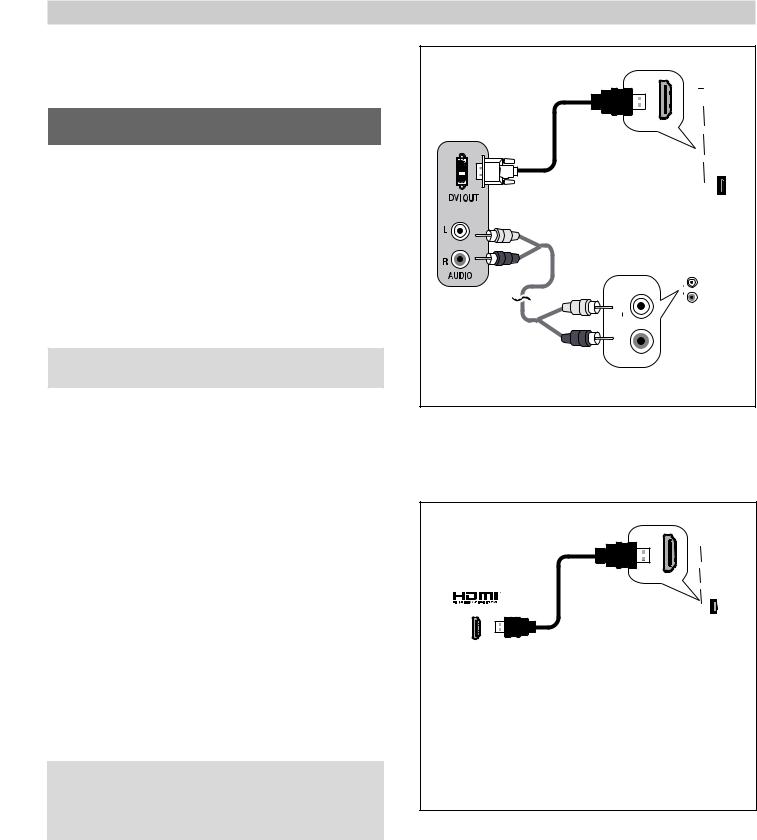
18 |
2. TV Setup |
Using the TV with a Personal Computer
Connecting a Computer to the TV
Use one of the connection methods listed below based on your computer’s video output.
Computer |
Video Connection |
Audio |
|
Video Output |
Connection |
||
|
|||
|
|
|
|
Digital DVI |
DVI-to-HDMI cable |
Stereo audio |
|
|
or an HDMI cable |
cables |
|
|
with an HDMI-to- |
|
|
|
DVI adapter |
|
|
|
|
|
|
|
Note: If the computer’s audio output |
||
|
is a single mini jack, a mini audio-to- |
||
|
RCA-male “Y” adapter cable is also |
||
|
required. |
|
|
|
|
|
|
HDMI |
HDMI-to-HDMI |
No additional |
|
|
cable |
audio connec- |
|
|
|
tion is required. |
|
IMPORTANT
This TV accepts digital computer signals only.
1.See the TV specifications in Appendix A to confirm that your computer signal is compatible with the TV.
2.Connect the computer’s digital signal output to one of the TV’s HDMI jacks. See the connection diagrams for the method suited to your equipment.
3.Connect the computer’s audio output using one of these options:
•For digital DVI signals, connect analog left/right audio to the TV’s DVI PC AUDIO INPUT jacks.
•For HDMI signals, no additional audio connection is required.
4.Power on the TV and computer. The TV will detect the connection and display the Auto Input Sensing screen.
5.In the Auto Input Sensing screen, press  to highlight PC in the list of device types. It is important to use the name PC so that the TV can process the video signal correctly.
to highlight PC in the list of device types. It is important to use the name PC so that the TV can process the video signal correctly.
6.Press EXIT to close the Auto Input Sensing screen.
Note: If your computer provides digital audio output (coaxial or digital), you can connect it directly to a digital A/V receiver and bypass the TV.
Computer with |
2. |
|
|
|
|
|
|
|
|
DVI and stereo |
|
|
4 |
|
audio outputs |
|
|
|
|
|
|
|
3 |
|
2. |
|
|
|
|
|
|
|
2 |
|
|
TV main |
|
1 |
|
|
panel |
|
|
|
|
|
|
|
|
|
|
IR-NetCommand |
|
S-VIDEO |
|
|
Output / External |
|
|
|
|
Controller Input |
|
|
|
|
INPUT3 |
|
|
|
|
|
|
Pr080i) |
|
|
VIDEO |
|
20p / 1 |
|
|
L |
|
Pbp/7 |
|
|
AUDIO |
|
0i / 480 |
3. |
|
R |
|
(48 |
|
|
|
||
|
DVI/PC |
Y |
Y/ VIDEO |
|
|
L |
|
L |
|
|
|
|
||
|
DVI/PC |
AUDIO |
|
AUDIO |
|
|
|
R |
|
|
L |
R |
|
|
|
|
|
DIGITAL |
|
|
|
|
|
|
|
|
|
|
AUDIO |
|
AUDIO |
|
|
OUTPUT |
|
AVR AUDIO |
|
||
|
|
OUTPUT |
|
|
|
R |
|
|
|
|
3. |
|
|
|
|
|
ANT2/AUX |
|
ANT1/MAIN |
A DVI connection from a personal computer requires a separate audio connection. Computer connected to the TV main panel (above).
Computer with |
2. |
HDMI audio/video output
1
2.
TV main panel
An HDMI-to-HDMI connection carries all video and audio on a single cable.
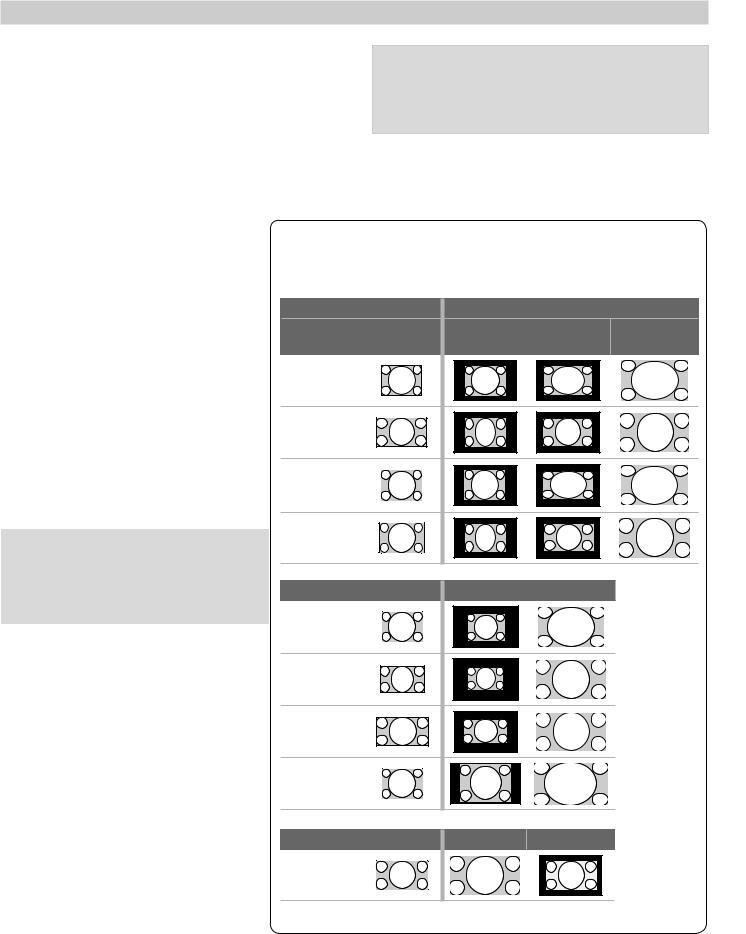
2. TV Setup |
19 |
Using the TV with a Personal Computer
Computer Video Adjustments
1.Power on the computer if it is not already on.
2.Select PC from the Input Selection menu. To do this, press INPUT to open the Input Selection menu, move the highlight to the PC icon, and press ENTER.
Tip
Set the computer’s screen saver to display a pattern after several minutes of inactivity. This acts as a reminder that the TV is powered on.
3.Working from the computer, change the resolution of the computer image. View the computer image on the TV and maximize the computer resolution while maintaining a suitable aspect ratio for the image.
4. Perform TV video adjustments. Press |
Computer Display Formats |
|
||
VIDEO repeatedly to access video- |
|
|
|
|
adjustment options. The following |
|
|
|
|
additional adjustments are available |
|
|
|
|
for computer video: |
Computer Signal |
As Displayed on TV Screen |
||
Horiz Position (Horizontal Position) |
||||
Original Format |
4 X 3 |
16 X 9 |
||
Manually adjust the horizontal |
||||
Standard |
Standard |
|||
position. |
|
|||
|
|
|
||
Vert Position (Vertical Position). |
VGA |
|
|
|
Manually adjust the vertical position. |
640 X 480 |
|
|
|
5. Press FORMAT repeatedly to find the |
WVGA |
|
|
|
picture format best suited to the |
|
|
||
image. See the chart on this page |
848 X 480 |
|
|
|
showing how different computer reso- |
|
|
|
|
lutions can be displayed on the TV. |
SVGA |
|
|
|
|
|
|
||
|
800 X 600 |
|
|
|
Distortion in Computer Images |
WSVGA |
|
|
|
|
|
|
||
Computer images may show distortion |
|
|
|
|
when viewed on the TV, e.g., lines that |
Original Format |
Standard |
Zoom |
|
should be straight may appear slightly |
||||
curved. |
XGA |
|
|
|
|
|
|
||
Image Resolution |
1024 X 768 |
|
|
|
|
|
|
||
Your Mitsubishi TV can display resolutions |
PC 720p |
|
|
|
1280 X |
|
|
||
from standard VGA (640 x 480) through |
|
|
||
|
|
|
||
1920 x 1080 signals at a refresh rate of |
WXGA |
|
|
|
60 Hz. See Appendix A, “Specifications” |
|
|
||
(page 66) for more on compatible screen |
1360 X 768 |
|
|
|
resolutions. |
|
|
|
|
In most cases, the computer will select |
SXGA |
|
|
|
|
|
|
||
the best resolution match to display on |
|
|
|
|
the TV. You can override this setting if you |
|
|
|
|
wish. Refer to your computer operating |
Original Format |
Standard |
Reduce |
|
system’s instructions for information on |
||||
PC 1080p |
|
|
||
changing the screen resolution. |
|
|
||
You may need to restart the computer for |
1920 X 1080 |
|
|
|
|
|
|
||
changes to take effect. |
|
|
|
|
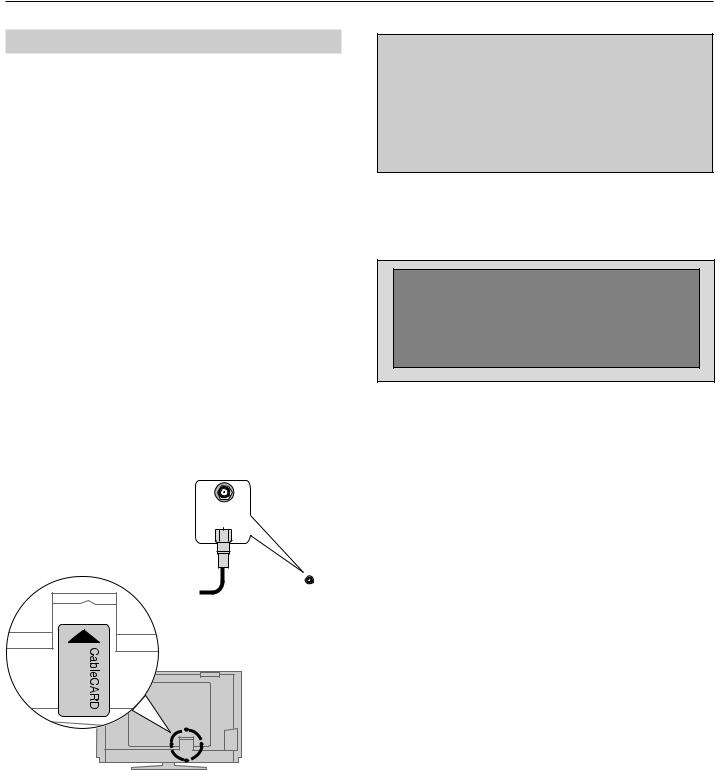
20 |
2. TV Setup |
Using a CableCARD
246 Series TVs
The CableCARD™ system allows your TV to receive, decode, and unscramble the premium digital channels included in your cable TV subscription without the use of a cable box. The system is unidirectional, meaning that certain digital cable services, such as requests for video-on-demand and pay-per-view programs, a cable operator’s enhanced program guide, and dataenhanced television services may require use of a set-top box instead. For more information, call your local cable operator.
Note: CableCARD requires the TV’s Fast Power On setting. If you insert a CableCARD, the TV will automatically override a Low Power setting and change to the Fast Power On setting.
Installing a CableCARD
1.Connect your primary incoming cable to
ANT1/MAIN on the back of the TV.
2.Power on the TV.
3.Insert the CableCARD (“S” type only) into the CableCARD slot with the front of the card oriented as shown in the diagram below.
TV main panel
ANT1/MAIN
HDMI
4
3
2
1
S-VIDEO
(480i 480p/ 720p/ 1080i)/
L
AUDIO
R
INPUT1
DIGITAL
AUDIO
OUTPUT
ANT2/AUX ANT1/MAIN
To ANT 1
4.Wait a few moments while the CableCARD initializes. A message will display on screen when initialization is complete.
Displaying CableCARD Information
To display information needed by your service provider to start cable service, press MENU and when the Main menu appears, press 9 9 9.
In order to start cable
service for this device, please contact your cable provider
1-800-xxx-xxxx
CableCARD(tm): xxx-xxx-xxx-xxx-xxx-x Host: xxx-xxx-xxx-xxx-x
Data: xxx-xxx-xxx-xx UnitAddress: xx-xxxxx-xxxxx-xxx
Press EXIT to exit.
Sample CableCARD information screen. Write down the information before contacting your cable provider.
CableCARD Menu
CableCARD menu
Network Setup
CableCARD(tm) Status
CableCARD(tm) Pairing
Conditional Access
Sample CableCARD menu
To display the CableCARD menu with links to applications from your cable provider:
1.While watching CableCARD, press INPUT to open the
Input Selection menu.
2.With the CableCARD icon highlighted, press MENU to open the CableCARD menu.
3.Press 
 to highlight a link, then press ENTER to access the linked page.
to highlight a link, then press ENTER to access the linked page.
4.To redisplay the CableCARD menu, repeat steps 1 and 2.
5.Press EXIT to return to TV viewing.
If there are technical problems with the CableCARD, an error screen automatically displays with information that may be needed by your cable provider when you call them for assistance.
Moving Through Other CableCARD Screens
In addition to CableCARD menus, other CableCARD application screens may display and require you to make additional selections. When using these screens on your Mitsubishi television:
•Blue text denotes a function. Press ENTER to perform the function.
•You cannot move backward through the links. To exit the CableCARD system, press EXIT. The CANCEL key may not work with some CableCARD screens.
Contact your cable provider if you have any problems with the application screen displays.
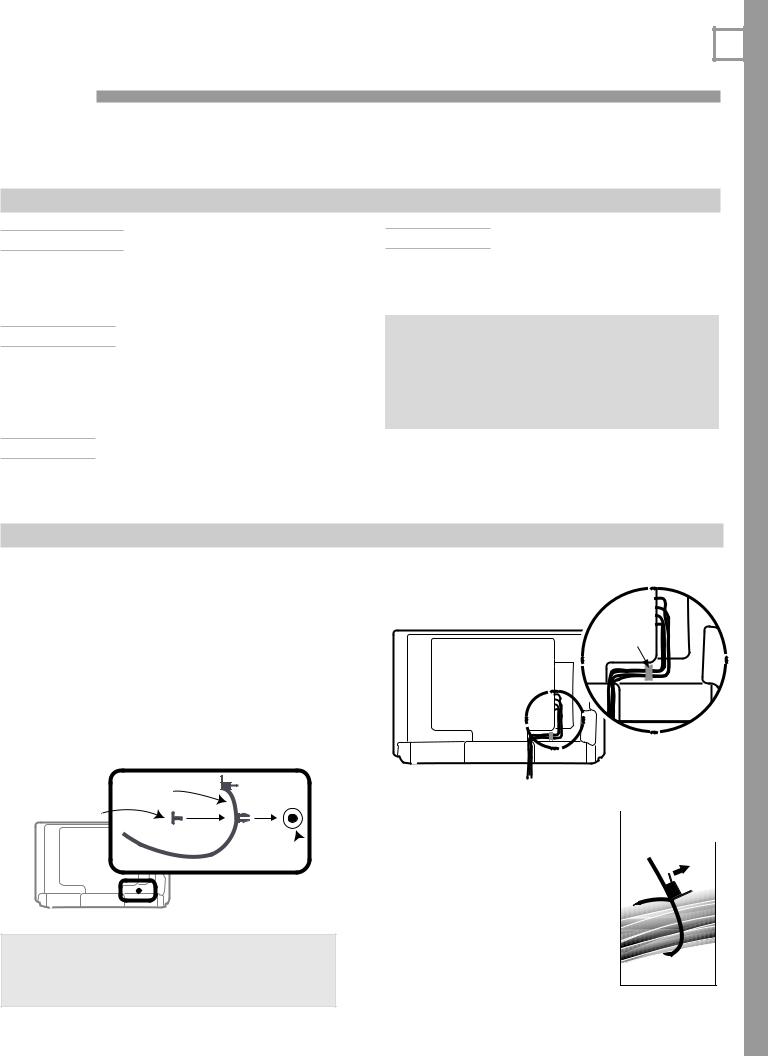
3 TV Connections
21 |
Before You Begin
Auto Input Sensing
The TV’s Auto Input Sensing feature automatically recognizes most connections and prompts you to identify the type of device connected. See page 14 for more on Auto Input Sensing.
Connection Types
Review the connection types available on your input devices and use connections that will give the best video quality. For example, choose HDMI over component video, and choose component video over S-video or composite video.
Picture Quality
For best picture quality, route signals directly from the input device to the TV; avoid routing video signals through an A/V receiver, for example.
Surround Sound
For best surround sound audio quality, route audiosignal cables or HDMI cables from the source device directly to your A/V receiver or sound system.
IMPORTANT
Accessory items such as cables, adapters, splitters, or combiners required for TV connections are not supplied with the TV. These items are available at many electronics stores.
Cable Management
One cable tie with a locking pin is supplied with the accessories. Use the tie to keep cables organized and connected.
Installing the Cable Tie
1.Remove the locking pin from the cable tie and insert the anchor prongs into the hole on the back of the TV.
2.Reinsert the pin in the cable tie to secure the tie to the TV.
$BCMF UJF
1JO
#BDL PG 57
)PMF JO  CBDL PG 57
CBDL PG 57
IMPORTANT
Be sure to leave enough cable slack below the cable tie to allow the TV to swivel freely. Without enough slack, there is a risk of damaging the cables and the TV.
Cable Routing
Cable tie
Cable routing on back of TV
Unlatching the Cable Tie |
|
Pry up tab |
|
||
|
to release |
|
|
|
Pry up the latch tab and push or pull the free end of the tie through the latch.
You may be able to lift the latch tab by pinching the tab and latch body between your thumb and index finger. You may find it easier to pry up the latch tab using a plastic wallet card or similar object.
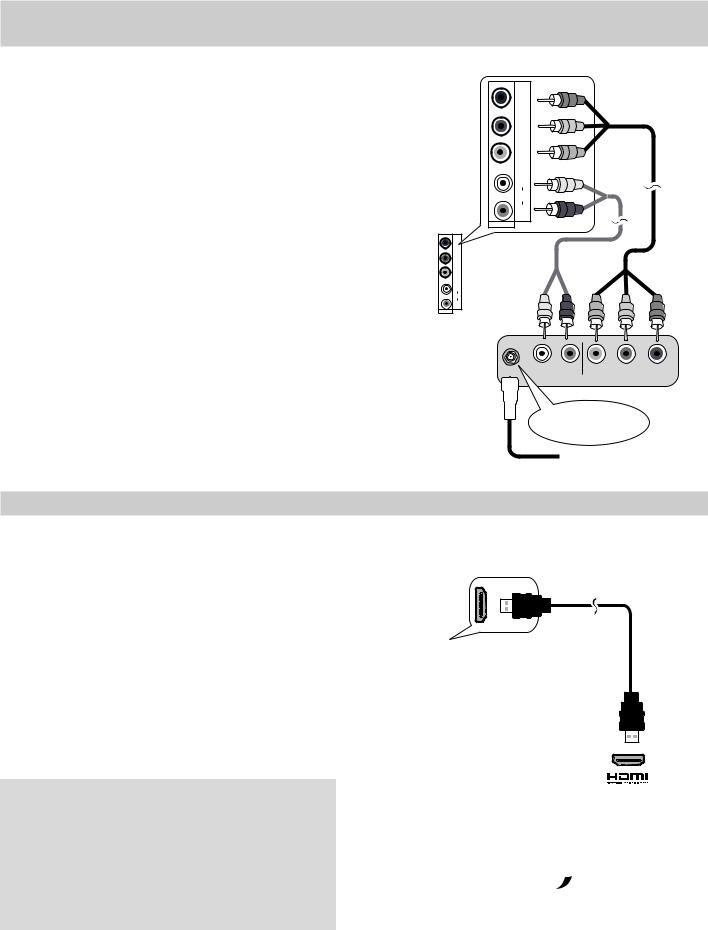
22 |
3. TV Connections |
HDTV Cable Box or Satellite Receiver, DVD Player, or Other Device with Component Video
If your cable box or satellite receiver has an HDMI output, use the connections for HDMI devices described on this page.
Required: RCA component video cables, left/right analog stereo audio cables.
1.Connect RCA-type cables from the Y Pb Pr outputs on the device to the Y Pb Pr inputs on the TV main panel, matching the colored green, blue, and red connections.
2.Connect left (white) and right (red) audio cables from the device to AUDIO L and R on the TV main panel.
3.Cable Box or Satellite Receiver Only: Connect the cable from the outside cable or satellite service to CABLE IN or SATELLITE IN on the cable box or satellite receiver. See your device’s owner’s guide for instructions and cable compatibility.
Note: To hear digital surround sound, connect the digital audio output from the device directly to your digital A/V receiver.
Figure 1. Connecting a device with component video outputs
HDMI |
|
Pr080i) |
|
4 |
|
0p / 1 |
1. |
|
|
2 |
|
|
|
Pbp/7 |
|
3 |
|
i / 480 |
|
|
|
(480 |
|
2 |
|
Y/ VIDEO |
|
|
|
L |
|
1 |
|
AUDIO |
|
IR-NetCommand |
S- |
R |
2. |
Output / External |
|
||
Controller Input |
|
INPUT1 |
|
|
|
||
INPUT3 |
|
|
|
|
P |
|
|
L |
Pbp/720p/ |
TV |
|
AUDIO |
/ 480 |
|
|
0i |
main |
|
|
|
(48 |
|
|
DVI/PC |
|
|
|
|
panel |
|
|
L |
L |
|
|
AUDIO |
AUDIO |
|
|
R |
R |
2. |
1. |
|
|
||
AVR AUDIO |
|
|
|
OUTPUT |
|
|
|
ANT2/AUX |
ANT1/MAIN |
|
Pr |
|
|
||
|
|
3. |
CABLE IN or |
Incoming from |
|||
cable service or |
SATELLITE IN |
|
|
satellite dish |
|
HDMI Device (Cable Box, Satellite Receiver, DVD Player, or Other Device)
Required: HDMI-to-HDMI cable.
Connect an HDMI cable from the TV main panel to the HDMI device output. HDMI devices provide video and audio through the single cable.
Mitsubishi recommends you use category 2 (highspeed) HDMI cables to connect HDMI 1.3 source devices. High-speed category 2 cables bring you the full benefits of Deep Color and x.v.Color. See “HDMI Cable Categories,” page 10, for more on HDMI cable types.
IMPORTANT
HDMI and Audio Signals
Digital Surround Sound: The TV’s HDMI inputs can receive digital stereo audio signals only. To hear digital surround sound from an HDMI device, connect the device’s HDMI or digital audio output directly to your A/V receiver. See the Owner’s Guides for those devices for instructions.
HDMI
4 |
|
|
3 |
|
|
2 |
|
|
1 |
|
|
IR-NetCommand |
S-VIDEO |
|
Output / External |
|
|
Controller Input |
|
|
INPUT3 |
|
|
|
Pr080i) |
|
L |
Pbp/720p/1 |
Any HDMI |
AUDIO |
8 |
|
080i 4/ |
device |
|
DVI/PC |
(4 |
|
R |
|
|
L |
L |
|
AUDIO |
AUDIO |
|
R |
R |
|
|
DIGITAL |
|
|
AUDIO |
|
|
OUTPUT |
|
AVR AUDIO |
|
|
OUTPUT |
|
|
ANT2/AUX |
ANT1/MAIN |
TV main |
|
|
panel |
Figure 2. Connecting an HDMI device.
Note: HDMI inputs are 


 certified for proper interoperability with other products certified by Simplay™.
certified for proper interoperability with other products certified by Simplay™.

DVI Video Device (Cable Box, Satellite Receiver, DVD Player, or Other Device)
Connect DVI devices (digital only) to the TV’s HDMI input jacks.
Analog stereo audio cables and a DVI-to-HDMI cable or DVI/HDMI adapter and HDMI cable are required.
1.Connect the DVI-to-HDMI cable (recommended) or HDMI cable with DVI/HDMI adapter from the DVI device’s back panel to the TV’s HDMI jack.
Note: If you are using a DVI/HDMI adapter, it is important to connect the adapter to the DVI device for best performance.
2.Connect a set of audio cables from AUDIO OUT on the DVI device back panel to the DVI/PC INPUT
AUDIO on the TV main panel. Connect the red cable to the R jack and the white cable to the L jack.
Note: The HDMI connection supports copy protection (HDCP).
Some devices require connection to an analog input first in order to view on-screen menus and to select DVI as the ouput. Please review your equipment instructions for DVI connectivity and compatibility. 
|
TV |
Digital DVI device |
|
|
|
|
|
HDMI |
main |
|
|
4 |
panel |
DVI OUT |
R |
3 |
|
|
|
2 |
|
1. |
2. |
|
|
||
|
|
|
|
1 |
|
|
|
IR-NetCommand |
S |
|
|
Output / External |
|
|
|
Controller Input |
|
|
|
INPUT3 |
|
|
|
|
|
1. |
|
L |
|
|
|
R
DVI/PC
L
|
AUDIO |
|
R |
ANT2/AUX |
2. |
|
3. TV Connections |
23 |
Standard Cable Box, Satellite Receiver,
or Other Device with S-Video
Required: S-Video cable and left/right analog stereo audio cables.
1.Connect the cable from the outside cable or satellite service to CABLE IN or SATELLITE IN on the cable box or satellite receiver.
2.Connect an S-Video cable from S-VIDEO OUT on the cable box or satellite receiver back panel to INPUT 3 S-VIDEO on the TV main panel.
3.Connect left (white) and right (red) audio cables from AUDIO OUT on the cable box or satellite receiver to INPUT 3 AUDIO L and R on the TV main panel.
Note: Refer to the cable box or satellite receiver Owner’s Guide for cable or dish antenna connections to the receiver.
HDMI |
|
|
|
4 |
|
TV main panel |
Any S-Video |
|
|
device |
|
3 |
|
|
2. |
|
|
S-VIDEO 2. |
|
2 |
|
|
|
1 |
|
|
3. |
IR-NetCommand |
|
|
|
|
|
|
|
|
|
Connect audio |
|
|
1/ |
cables to INPUT |
|
|
Pr080i) |
3 AUDIO |
R |
|
0 |
||
|
p 0 2 |
|
|
L |
Pbp/7 |
|
AUDIO |
AUDIO |
|
|
|
R |
L |
|
|
DVI/PC |
|
|
|
|
|
|
|
L |
AUDIO |
|
|
AUDIO |
R |
|
|
R |
|
|
|
|
|
|
|
AVR AUDIO |
|
3. |
|
|
|
|
|
OUTPUT |
|
Incoming |
CABLE IN or |
|
|
||
|
|
cable from |
SATELLITE IN |
ANT2/AUX |
ANT1/MAIN |
wall |
|
Figure 4. Connecting a device with S-Video
Figure 3. Connecting a digital DVI device
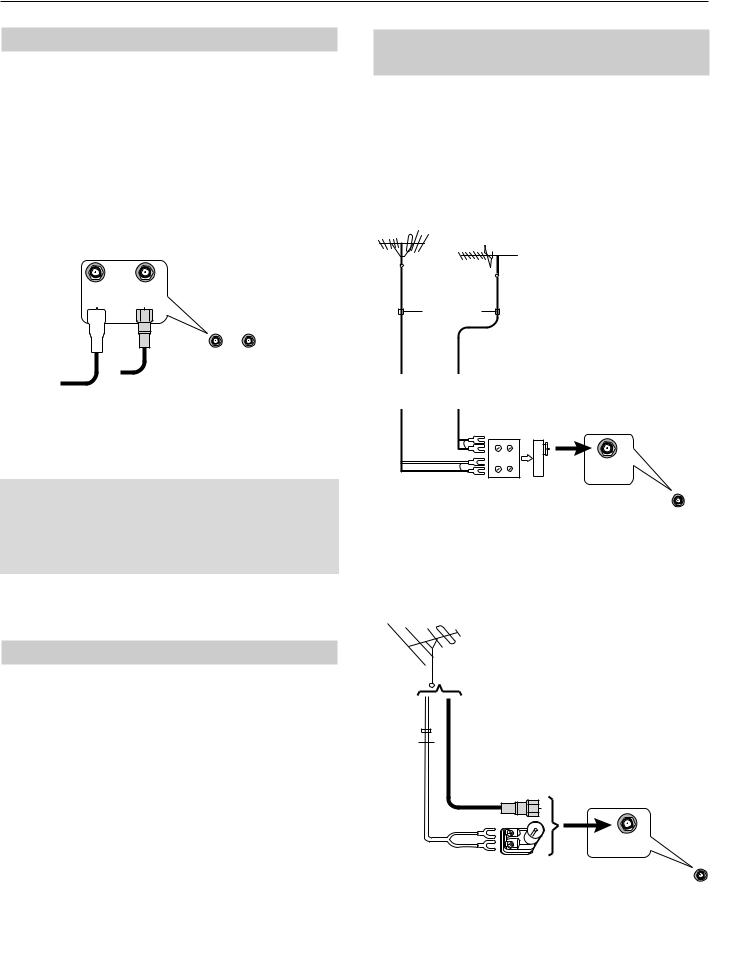
24 |
3. TV Connections |
Wall Outlet Cable (no cable box)
(can be used with a CableCARD™)
It is very important to connect the incoming cable for your primary viewing source to ANT 1.
1.Connect the primary incoming coaxial lead cable to ANT 1 on the TV main panel.
2.For an optional secondary antenna source, connect
an antenna (or cable) to ANT 2.Output / External
Controller Input
|
INPUT3 |
|
Pr080i) |
L |
Pbp/720p/1 |
|
i / 480 |
|
DVI/PC |
|
|
L |
L |
|
AUDIO |
AUDIO |
|
R |
R |
ANT2/AUX |
ANT1/MAIN |
|
|
AVR AUDIO |
|
|
OUTPUT |
|
|
ANT2/AUX |
ANT1/MAIN |
|
To ANT 1 |
|
To ANT 2 |
TV main panel |
|
Figure 5. Wall Outlet Cable
Mitsubishi strongly recommends you avoid using antennas with flat twin leads. Flat twin lead antenna wires are subject to interference which may adversely affect the performance of the TV. We recommend using coaxial antenna cable.
Antenna with a Single Lead
A. For an antenna with flat twin leads
Required: 300-ohm-to-75-ohm transformer.
A1. For an antenna with flat twin leads, connect the 300-ohm twin leads to the 300-ohm-to-75-ohm transformer.
A2. Push the 75-ohm side of the transformer onto ANT 1 on the TV main panel.
B.For cable or antenna with coaxial lead
Connect the coaxial lead directly to ANT 1 on the TV main panel.
Antennas with Separate UHF and VHF Leads
Required: UHF/VHF combiner
1.Connect the UHF and VHF antenna leads to the UHF/VHF combiner.
2.Push the combiner onto ANT 1 on the TV main panel.
|
|
|
HDMI |
|
|
|
|
|
4 |
VHF antenna |
UHF antenna |
|
3 |
|
|
|
|||
(channels 2–13) |
(channels 14–69) |
|
2 |
|
|
|
|
|
|
Flat twin lead |
|
|
|
|
|
|
|
|
1 |
|
|
TV |
IR-NetCommand |
S-VIDEO |
|
|
main |
Output / External |
|
|
|
Controller Input |
|
|
|
|
panel |
INPUT3 |
)i0 |
|
|
|
|
Pr08 |
External antenna |
|
|
L |
Pbp/720p/1 |
or cable |
|
|
AUDIO |
i / 480 |
|
Back |
Side |
L |
L |
|
view |
view |
DVI/PC |
|
|
|
AUDIO |
||
|
|
|
|
|
|
UHF |
|
|
R |
|
|
|
|
|
|
VHF |
2. ANT1/MAIN |
|
|
|
|
|
|
|
1.300-ohm-to75- ohm combiner
ANT2/AUX ANT1/MAIN
Figure 6. Connecting separate UHF and VHF Antennas
|
|
4 |
|
TV main panel |
3 |
||
|
|||
|
|
2 |
|
75-ohm |
|
1 |
|
|
S-VIDEO |
||
coaxial |
Output / External |
||
lead |
IR-NetCommand |
|
|
Controller Input |
|
||
|
INPUT3 |
|
|
300-ohm |
|
Pr080i) |
|
|
270p / 1 |
||
flat twin |
|
80 |
|
lead |
L |
Pbp/ |
|
AUDIO |
i / 4 |
||
B. |
|||
L |
L |
||
|
DVI/PC |
|
|
|
|
AUDIO |
|
|
|
R |
|
A2. |
ANT1/MAIN |
|
|
A1. Optional 300-ohm- |
|
|
|
to75-ohm matching |
|
||
transformer |
ANT2/AUX |
ANT1/MAIN |
|
|
|
||
Figure 7. Connecting a Single Antenna Lead
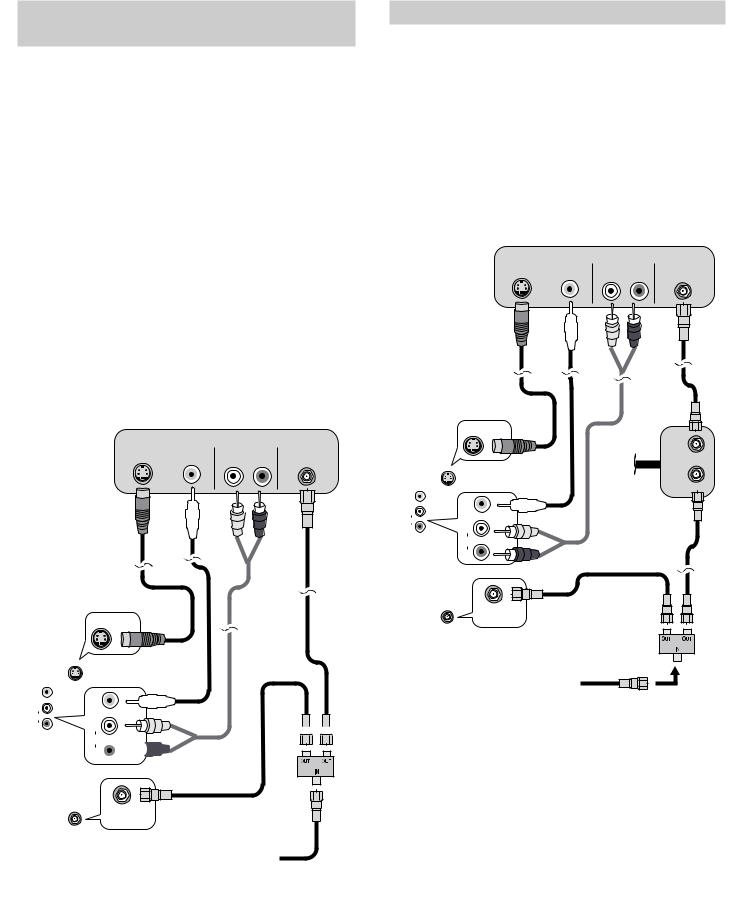
3. TV Connections |
25 |
VCR to an Antenna or
Wall Outlet Cable
Required: Two-way RF splitter, two coaxial cables, right and left analog audio cables, either S-video or composite video cable.
1.Connect the incoming cable or antenna to IN on the RF splitter.
2.Connect one coaxial cable from OUT on the RF splitter to ANTENNA IN on the VCR back panel.
3.Connect one coaxial cable from OUT on the RF splitter to ANT 1 on the TV main panel.
4.Connect either an S-Video or composite video cable from VIDEO OUT on the VCR back panel to a VIDEO composite or S-VIDEO jack on the TV main panel. Connect only one type of video cable; S-Video is recommended, if available.
5.To use the TV speakers with the VCR, connect left (white) and right (red) audio cables from AUDIO OUT on the VCR to the associated AUDIO L and R jacks on the TV main panel. If your VCR is mono (nonstereo), connect only the white (left) cable.
VCR |
VIDEO |
AUDIO OUT ANTENNA |
|
||
|
OUT |
|
|
L |
|
|
|
4. |
2. |
|
|
HDMI |
|
|
5. |
S-
S- |
4. |
2.
3.



 5.
5.
|
3. |
1. |
ANT1/MAIN |
|
ANT1/MAIN
TV main panel |
Incoming |
|
cable |
||
|
Figure 8. Connecting a VCR to allow recording from an antenna source.
VCR to a Cable Box (Audio & Video)
Required: Two-way RF splitter, three coaxial cables, right and left audio cables, S-Video or composite video cable, plus video and audio cables required to connect the TV to the cable box.
1.Connect the incoming cable to IN on the RF splitter.
2.Connect one coaxial cable from OUT on the RF splitter to CABLE IN on the cable box.
3.Connect one coaxial cable from OUT on the RF splitter to ANT 1 on the TV main panel.
4.Connect one coaxial cable from OUT on the cable box to ANTENNA IN on the VCR back panel.
VIDEO |
AUDIO |
ANTENNA |
|
OUT |
|||
|
|
VCR |
|
|
6. |
7. |
4. |
|
HDMI
TV |
|
|
|
main |
|
|
|
panel |
|
|
4. |
|
|
Cable |
|
S- |
|
box |
OUT |
|
|
5. |
|
|
6. |
|
|
S- |
|
|
|
|
|
Audio and |
|
|
|
video from |
2. |
|
|
cable box |
|
|
|
to TV |
|
|
|
7. |
|
ANT1/MAIN |
3. |
3. |
2. |
|
ANT1/MAIN
Incoming |
1. |
|
|
cable |
|
Figure 9. Connecting a VCR to a cable box
5.Connect the cable box outputs to the TV as shown in one of the options listed below. This connection allows the TV to receive the best available signal directly from the cable box.
•Figure 1, page 22: Component video output to the TV’s Y Pb Pr jacks; analog stereo audio to the associated AUDIO jacks.
•Figure 2, page 22: HDMI output to the TV’s HDMI jack.
•Figure 4, page 23: S-Video output to the TV’s INPUT 3 S-VIDEO jack; analog stereo audio to the INPUT 3 AUDIO jacks.
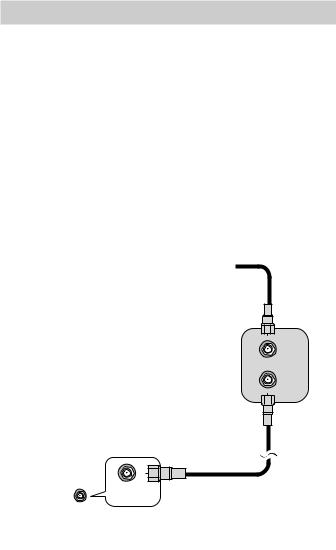
26 |
3. TV Connections |
6.Connect either an S-Video or composite video cable from VIDEO OUT on the VCR back panel to a VIDEO composite or S-VIDEO jack on the TV
main panel. Connect only one type of video cable. S-Video is preferable to composite video, if available.
7.To use the TV speakers with the VCR, connect left (white) and right (red) audio cables from AUDIO OUT on the VCR back panel to the associated INPUT AUDIO L and R on the TV main panel. If your VCR
is mono (non-stereo), connect only the white (left) cable.
Note: When using this connection configuration with the connections used in step 5, it is possible to view live cable programs through the VCR Device. For best picture quality always view live cable programs directly from the TV input connected to the cable box device.
Older Cable Box
Required: One coaxial cable.
Note: This connection is not recommended. The other connections described in this chapter provide better quality audio and video to the TV and allow NetCommand to work with the cable box.
1.Connect the incoming cable to IN on cable box.
2.Connect one coaxial cable from OUT on the cable box to ANT 1 on the TV main panel.
HDMI
4
|
|
Incoming |
|
|
3 |
cable |
|
|
|
|
|
|
2 |
|
|
|
|
|
1. |
|
1 |
|
|
IR-NetCommand |
S-VIDEO |
Cable |
IN |
Output / External |
|||
Controller Input |
|
||
INPUT3 |
)i |
box |
|
|
Pr080 |
|
OUT |
|
20p / 1 |
|
|
L |
Pbp/7 |
|
|
|
/ 480 |
|
2. |
L |
L |
TV main panel |
|
DVI/PC |
|
|
|
AUDIO |
AUDIO |
|
|
R |
R |
|
|
2.
AVR AUDIO
OUTPUT
ANT1/MAIN
ANT2/AUX ANT1/MAIN
Figure 10. Connecting an older cable box
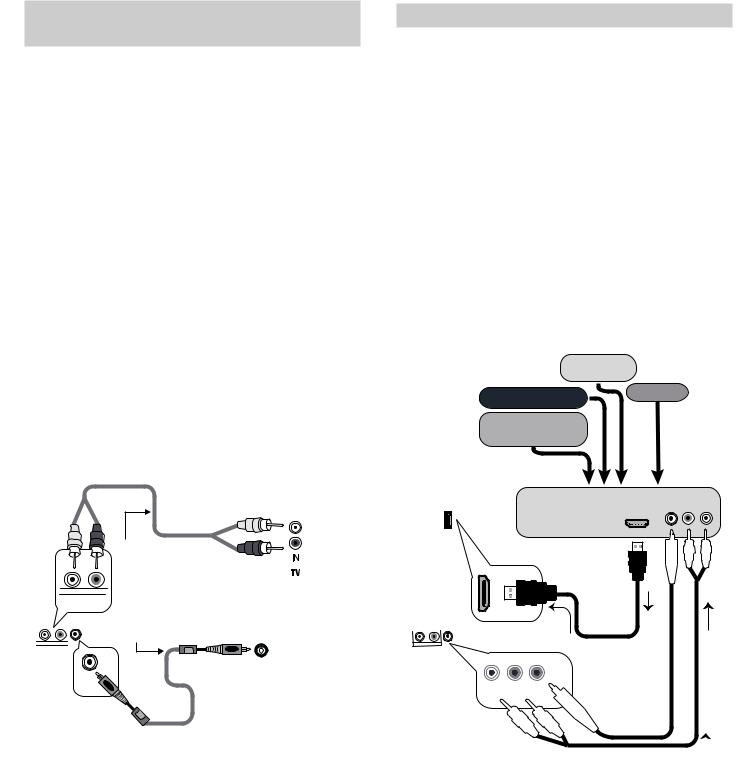
3. TV Connections |
27 |
A/V Receiver (Sound System) Using the TV’s Audio Output
Most setups require either a digital audio cable or analog stereo audio cables. To send audio from TV channels received on ANT 1, ANT 2, or devices connected directly to the TV, you must use one of the connections shown below.
The TV makes all audio available in digital and analog formats:
•Analog audio coming into the TV is output in digital stereo format on the DIGITAL AUDIO OUTPUT jack.
•Digital incoming audio is output on the analog AVR AUDIO OUTPUT L and R jacks.
Usually, only one of the following audio connections is required.
•To connect an analog A/V receiver
Connect left (white) and right (red) audio cables from AVR AUDIO OUTPUT L and R on the TV main panel to the TV AUDIO INPUT on the A/V receiver.
•To connect a digital A/V receiver with Dolby Digital surround sound and PCM audio support:
Connect one end of the digital audio cable to
DIGITAL AUDIO OUTPUT on the back of the TV. Connect the other end to the COAXIAL DIGITAL INPUT on the back of the A/V receiver.
|
2 |
|
|
|
1 |
|
|
IR-NetCommand |
|
S-VIDEO |
|
Output / External |
|
||
Controller Input |
|
|
|
INPUT3 |
|
|
|
L |
|
|
|
DVI/PC |
L |
R |
|
AVR AUDIO |
|||
L |
|||
|
OUTPUT |
||
|
|
||
AUDIO |
|
|
|
R |
|
|
|
|
|
DIGITAL |
|
|
|
AUDIO |
|
|
|
OUTPUT |
|
L
AVR AUDIO
OUTPUT
ANT2/AUX
Stereo analog cables |
|
|
(for connecting an |
|
|
analog A/V receiver) |
|
|
Digital coaxial cable |
OPTICAL |
|
(for connecting a |
||
INPUT |
||
digital A/V receiver) |
||
|
||
|
COAXIAL |
|
|
INPUT |
A/V receiver back panel
Figure 11. Connecting the TV to an A/V receiver
Note:
•On rare occasions, an HDMI signal may be copyrestricted and cannot be output from the TV as a digital signal. To hear these copy-protected signals through the A/V receiver, use the connection for an analog A/V receiver.
•Check the A/V receiver’s Owner’s Guide for information concerning use of the digital input and switching between digital sound and analog stereo sound from the TV.
A/V Receiver with HDMI Output
Required: One HDMI-to-HDMI cable
This option allows you to view content from devices connected to an A/V receiver. The A/V receiver can send audio and video to the TV over a single HDMI cable. You can use an HDMI connection as described here in addition to an audio connection from the TV’s audio output.
You may be able to use the TV’s remote control (with slide switch set to TV) to operate connected CECenabled HDMI devices. Experiment with your equipment to determine which functions are available to the TV’s remote control. See Appendix E, page 80.
This setup allows you to use NetCommand-controlled audio and video switching over the HDMI cable. See “A/V Receiver Control: Automatic Audio and Video Switching via HDMI” on page 63.
|
|
|
Cable box |
|
TV main |
|
DVD player |
VCR |
|
panel |
|
|||
|
|
|||
HDMI |
|
High-definition |
|
|
|
|
DVD player |
|
|
4 |
|
|
|
|
|
|
|
|
|
3 |
|
|
|
|
2 |
|
|
|
|
|
|
|
A/V receiver with |
HDMI OUT |
1 |
|
|
HDMI output |
|
IR-NetCommand |
S- |
|
|
|
Output / External |
|
|
|
|
Controller Input |
|
|
|
|
INPUT3 |
|
|
|
|
L |
|
|
|
|
L |
|
|
HDMI |
|
R |
|
|
cable |
|
AUDIO |
|
|
(Video to TV) |
|
|
|
|
DIGITAL |
|
|
|
|
AUDIO |
|
|
ANT1/MAIN |
|
OUTPUT |
Optional |
|
AVR AUDIO |
|||
|
|
L |
R |
|
|
|
|
OUTPUT |
analog or |
|
|
|
digital audio |
|
|
|
|
connection |
|
Audio from TV to A/V Receiver 
Figure 12. An A/V receiver connected to the TV with an HDMI cable may offer special control capabilities.
To hear sound from devices connected to the TV only, use the optional audio connection to send audio from the devices through the TV to the A/V receiver..
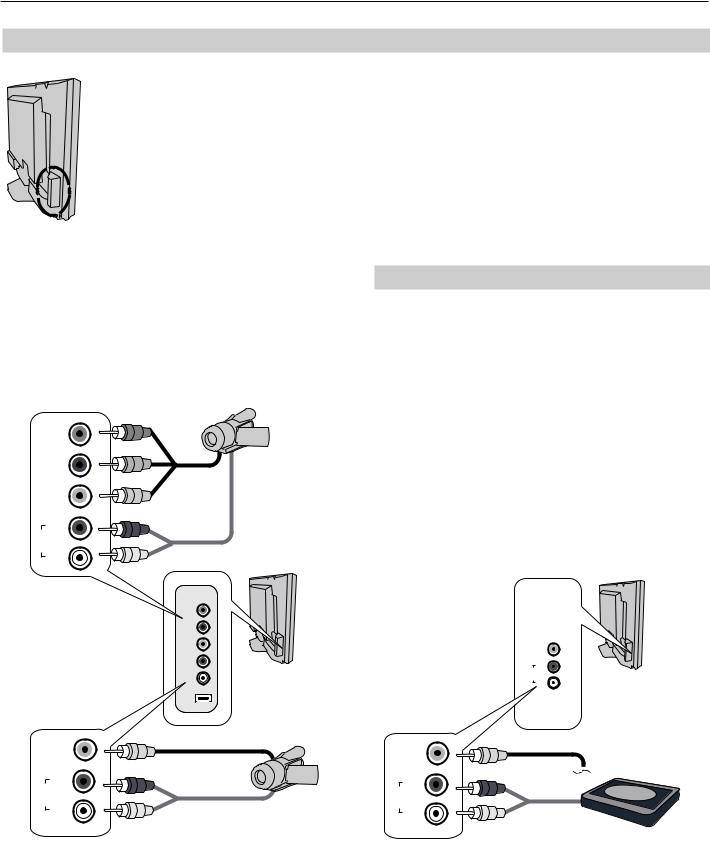
28 |
3. TV Connections |
Camcorder
Convenience input jacks on the TV’s side panel offer the easiest way to connect a camcorder. Two different connection options are described on this page. You can alternatively use any of the jacks on the main connection panel.
Use jacks on the TV’s side panel to connect a camcorder
A: Y Pb Pr Component Video Connection
Required: Component video and analog stereo audio cables supplied with the camcorder.
1.Connect component video cables from VIDEO OUT on the camcorder to the TV’s Y Pb Pr component convenience jacks.
2.Connect left (white) and right (red) audio cables from AUDIO OUT on the camcorder to AUDIO L and R on the TV.
Pr
Pb |
1. |
A: Component |
|
video plus |
|
Y/ |
|
audio |
VIDEO |
|
|
OI |
2. |
|
R |
|
|
AUD |
|
|
L |
|
TV back |
|
|
|
|
INPUT 4 |
|
|
Pr |
|
|
Pb |
|
|
Y/ |
|
|
VIDEO |
|
|
R |
|
|
AUDIO |
|
|
L |
TV conve- |
|
|
|
|
USB |
nience |
|
|
panel |
Y/ |
|
1. |
|
|
|
VIDEO |
|
|
R |
2. |
|
DIO |
|
|
AU |
|
|
L |
B: Composite video |
|
|
|
plus audio |
Figure 13. Two connection options for a camcorder.
B: Composite Video Connection
Required: Composite video and analog stereo audio cables supplied with the camcorder.
1.Connect the composite video cable from VIDEO OUT on the camcorder to VIDEO/Y on the front of the TV.
2.Connect left (white) and right (red) audio cables from AUDIO OUT on the camcorder to AUDIO L and R on the front of the TV.
Audio-Only Device
If you wish to connect an audio-only device to the TV, such as an audio CD player or an MP3 player, follow these instructions.
1.Insert an unused RCA-style connector into the INPUT 4 VIDEO/Y jack. The presence of this connector activates the TV’s Auto Input Sensing feature.
2.When the Auto Input Sensing screen displays, name the new input CD/Audio or MP3 Player.
3.Connect left (white) and right (red) audio cables from AUDIO OUT on the device to AUDIO L and R on the TV.
4.Keep the connector in the VIDEO/Y jack while using the audio-only device.
|
|
TV back |
|
INPUT 4 |
|
|
Pr |
|
|
Pb |
|
|
Y/ |
|
|
VIDEO |
|
|
R |
|
|
AUDIO |
TV conve- |
|
L |
|
|
USB |
nience |
|
|
panel |
Y/ |
|
1. |
|
|
|
VIDEO |
|
|
R |
2. |
|
DIO |
|
|
AU |
|
|
L |
|
|
|
|
Audio-only device |
Figure 14. First insert an unused RCA-type connector into the VIDEO/Y jack on the TV side or main panel before connecting audio cables.

4 TV Operation and Features
29 |
Choosing a Viewing Source
Input Selection menu
Choose a viewing source from the Input Selection menu. The current TV input appears as a full-color icon in this menu.
1.Press INPUT to display the Input Selection menu. If there are only two inputs to the TV, INPUT switches between them without displaying the menu.
2. Highlight an input icon using |
. |
3.Press ENTER to switch to the input and close the menu.
More About the Input Selection Menu
•To assign meaningful names to the icons, see the
Inputs > Name menu, page 50.
•To rearrange the icons, see the Inputs > Order menu, page 50.
TV Tips
Turning the TV On or Off
To turn the TV on or off, point the remote control at the front of the TV and press the POWER button. Alternatively, press the POWER button on the TV’s control panel.
Controlling Sound Volume
•Press VOL / to adjust the sound level.
to adjust the sound level.
•See also “Controlling A/V Receiver Sound Volume” on page 16.
Changing Channels (antenna sources)
To change channels:
•Enter the channel number using the number keys on the remote control and press ENTER. For a two-
Sleep Timer
The Sleep Timer turns the TV off after the length of time you set. To set the TV to turn on at a certain time, see the Setup > Timer menu on page 47.
Setting the Sleep Timer
1.Press SLEEP on the remote control.
2.Press SLEEP additional times to increase the time in 30-minute increments up to the maximum of 120 minutes.
3.Press EXIT or wait five seconds without pressing any keys for the message to disappear.
4.Press SLEEP to view the time remaining before the sleep timer turns off the TV.
Cancelling the Sleep Timer
1.Press SLEEP to display the on-screen message.
2.Press SLEEP repeatedly until OFF is displayed.
Note: After five seconds of inactivity, the message box will disappear.
part digital channel, such as 3-1, press 3 |
— |
1 |
CANCEL |
to enter a dash (separator).
•Press CH/PAGE  /
/ to change channels one channel at a time.
to change channels one channel at a time.
•Press and hold CH/PAGE  /
/ to move quickly through channels.
to move quickly through channels.
•Press QV (QuickView) to switch back to the previously tuned channel.
•Press GUIDE to display ChannelView channel listings, highlight a channel, and press ENTER.
•Use the Fav (Favorites) feature to set up lists of favorite channels and tune to them with the FAV key. See Setup > Edit > Fav1–Fav6 on page 45.
NOTE: Perform channel memorization to make finding channels easier. See Setup > Scan, page 44.
